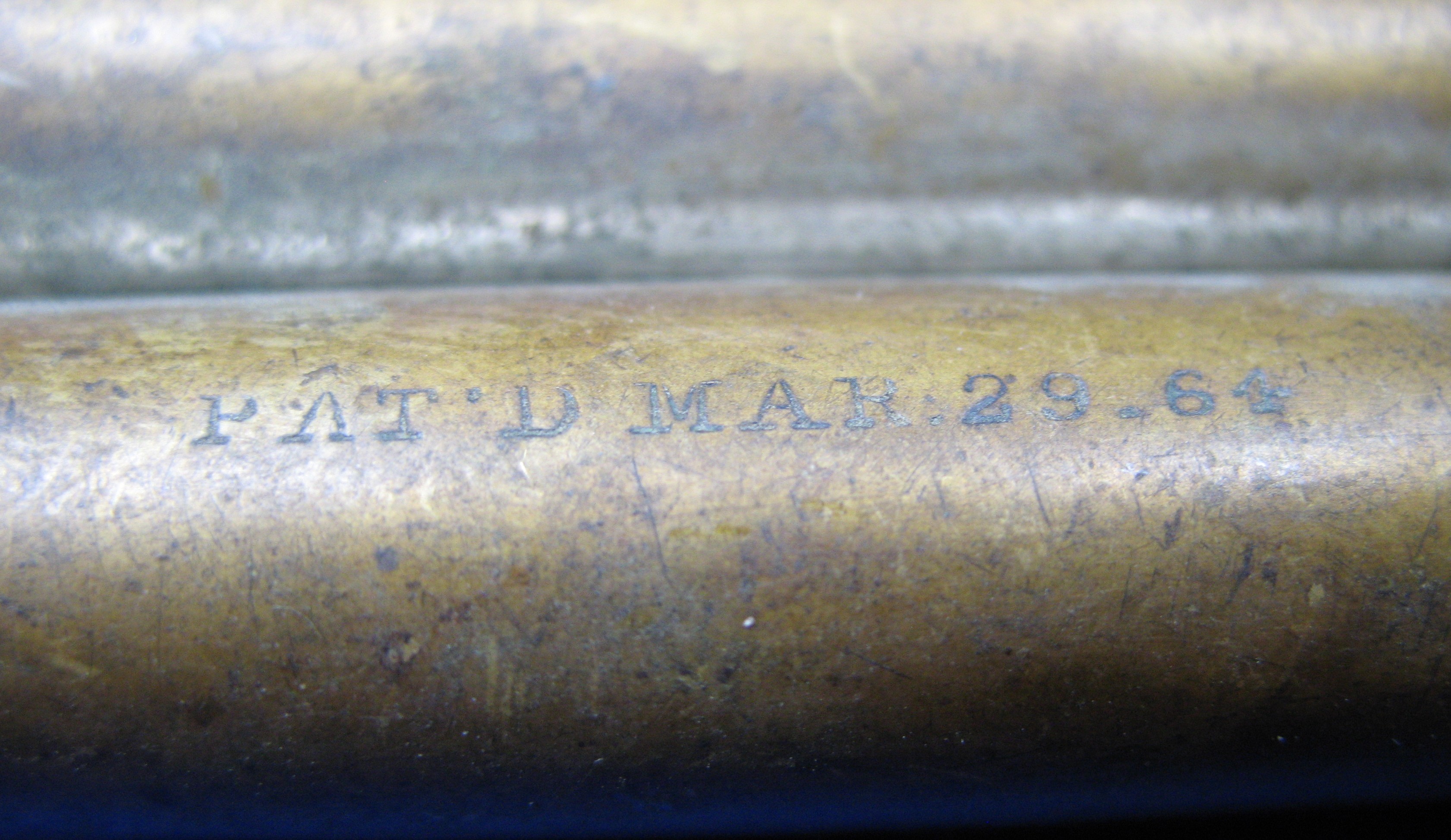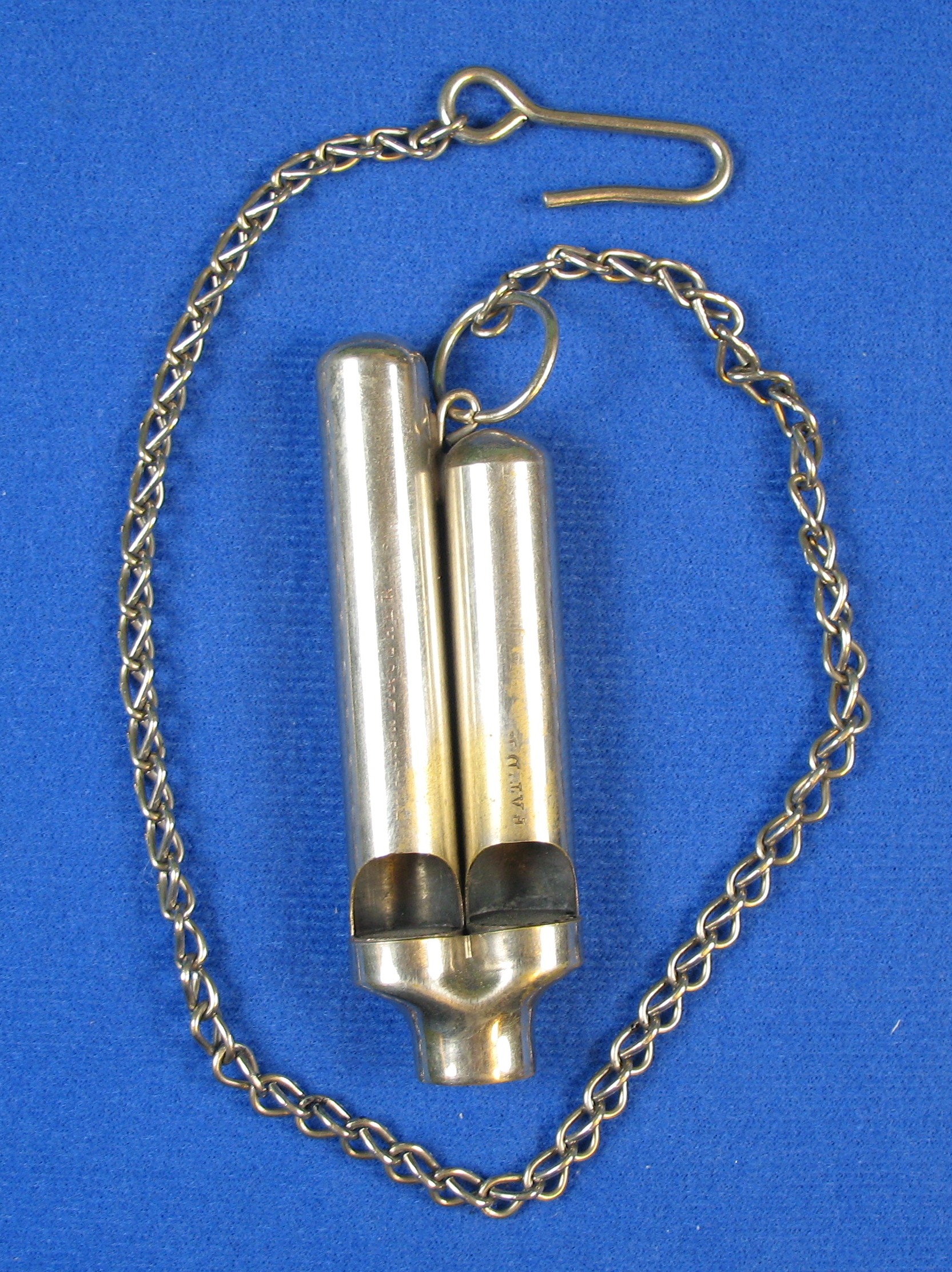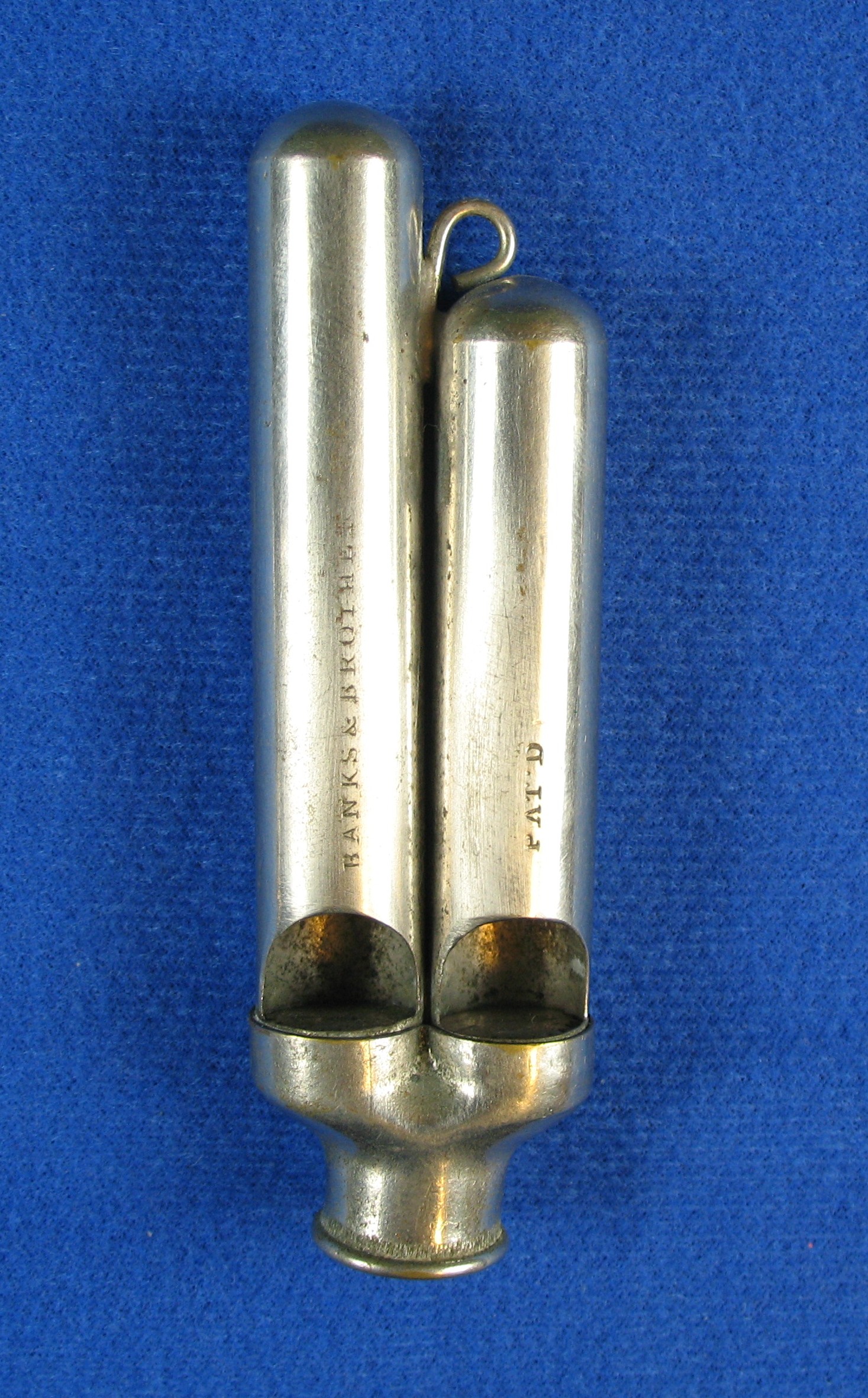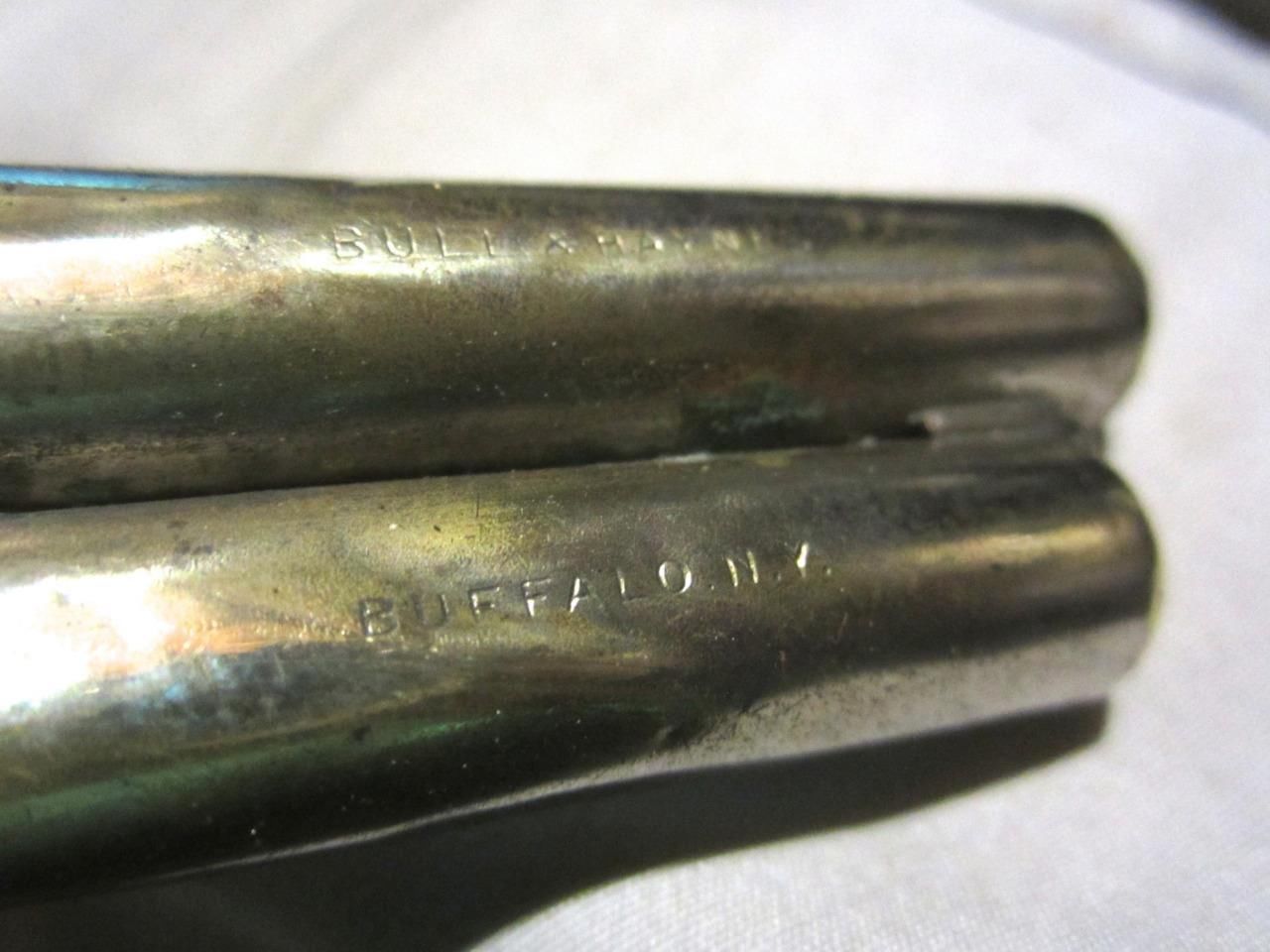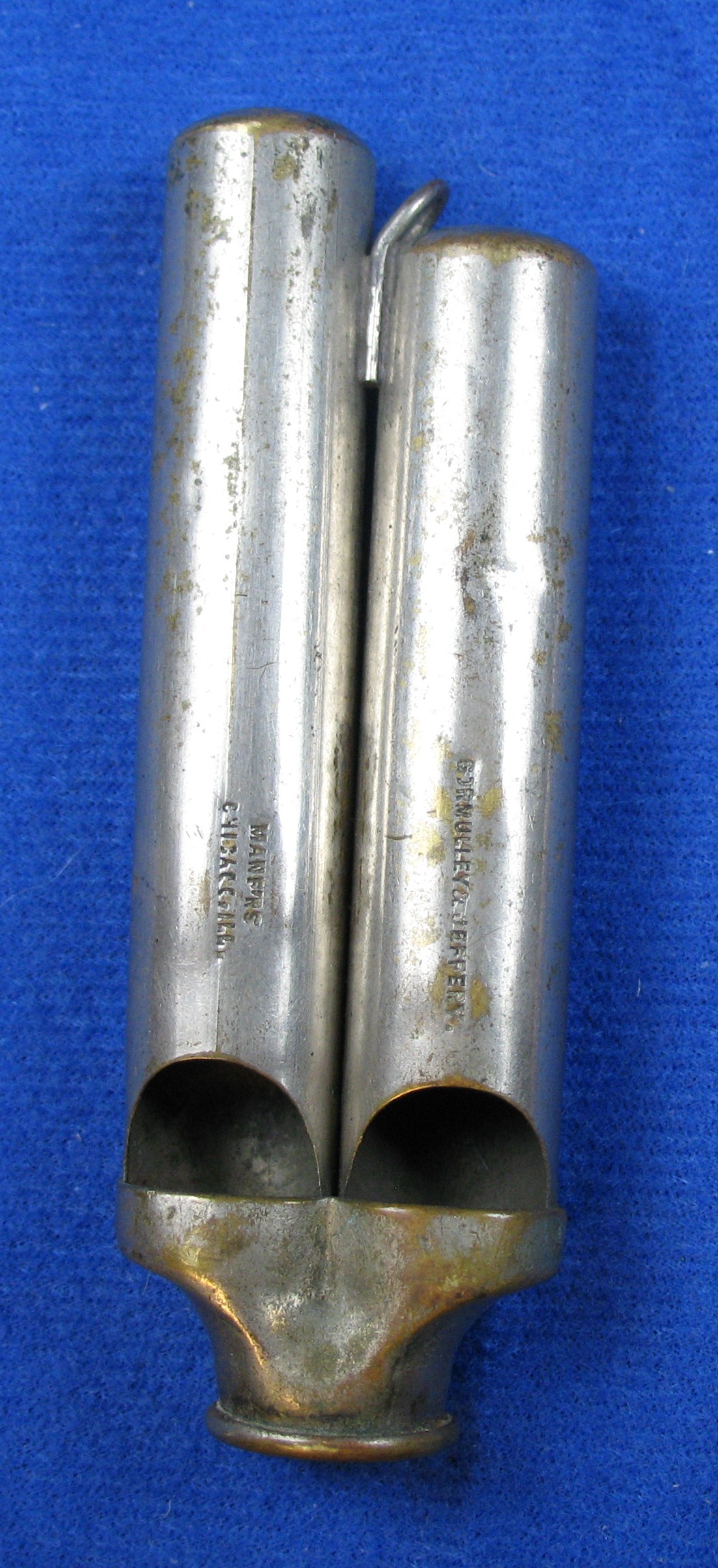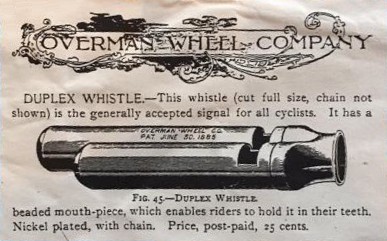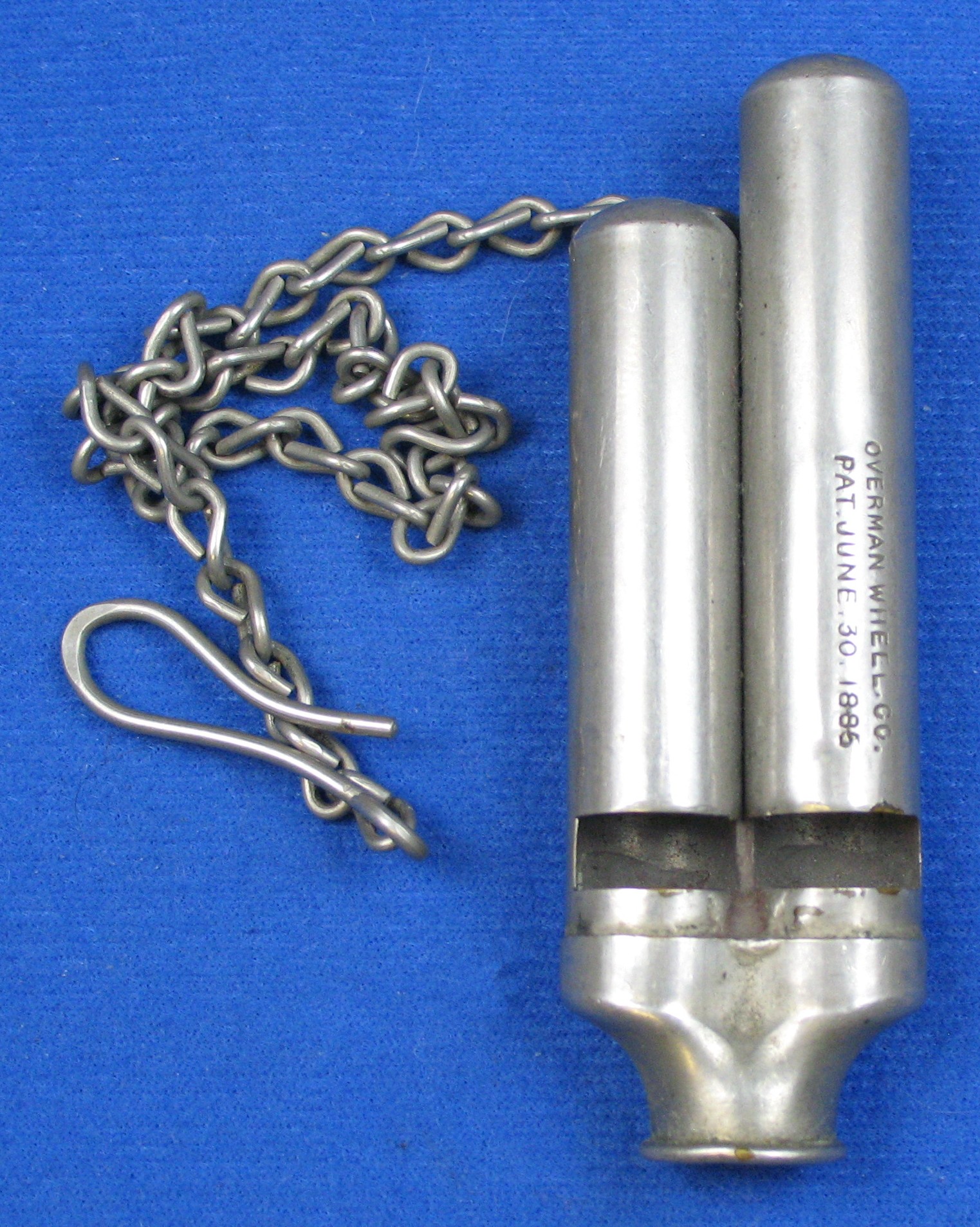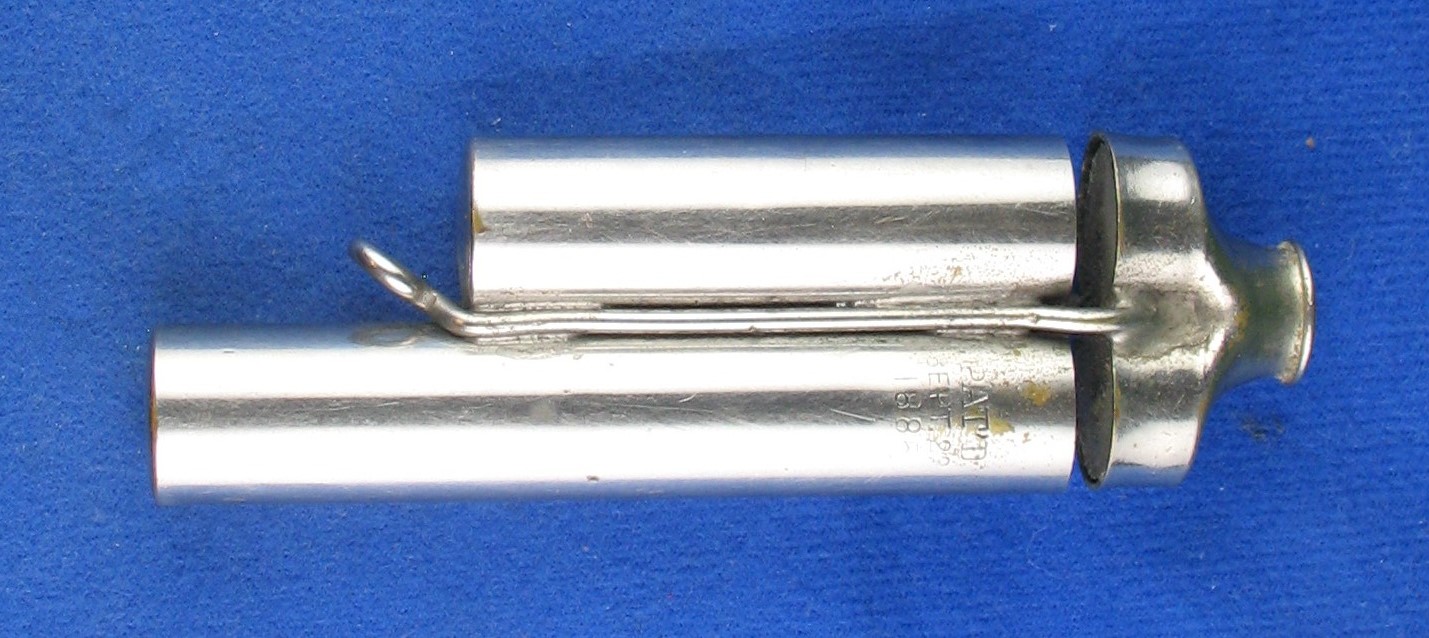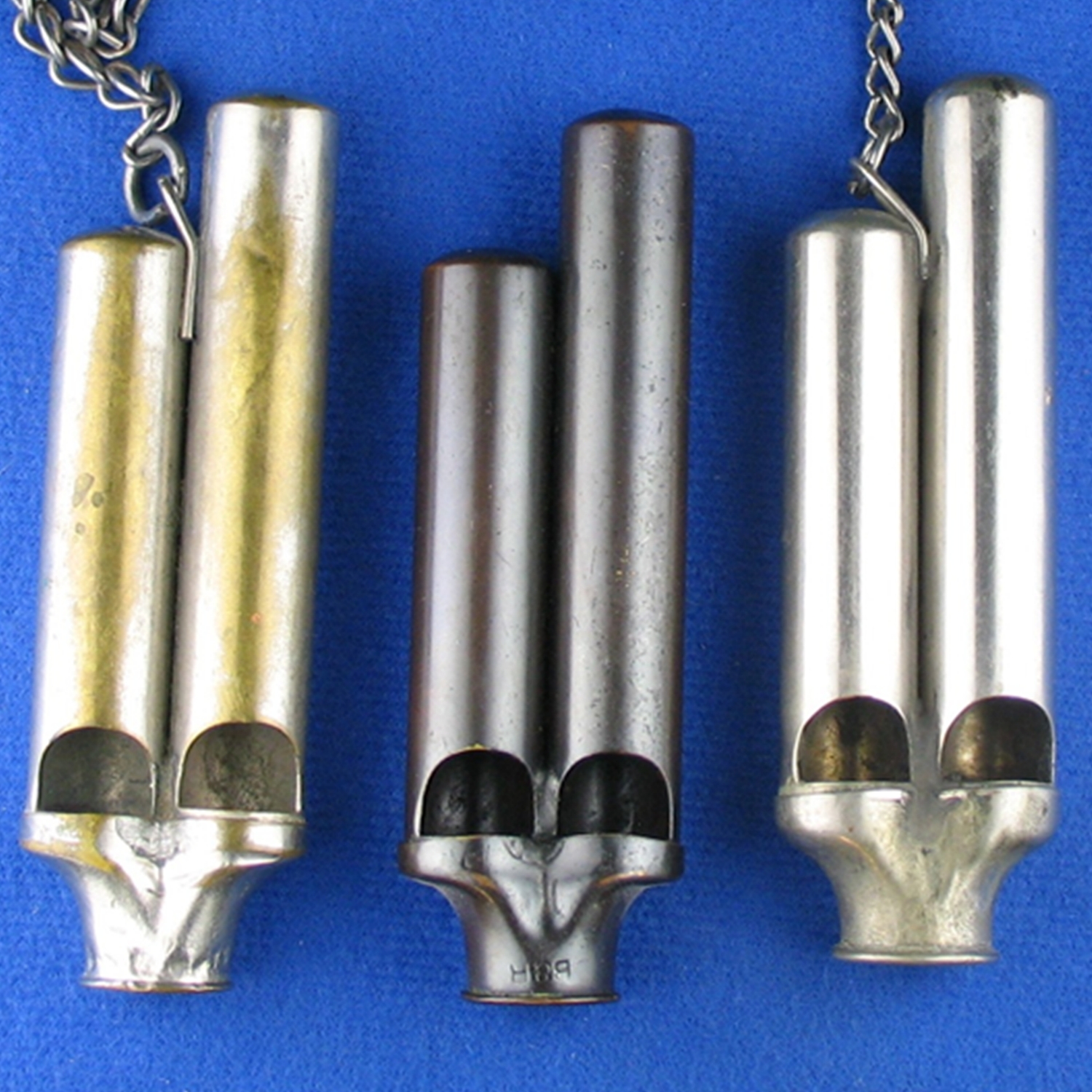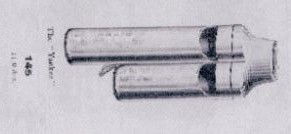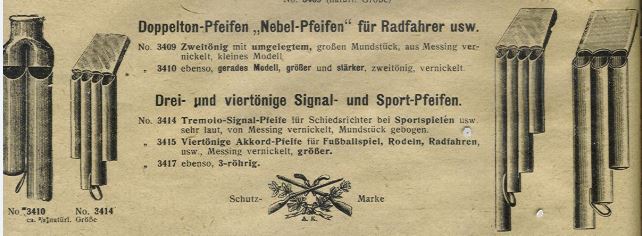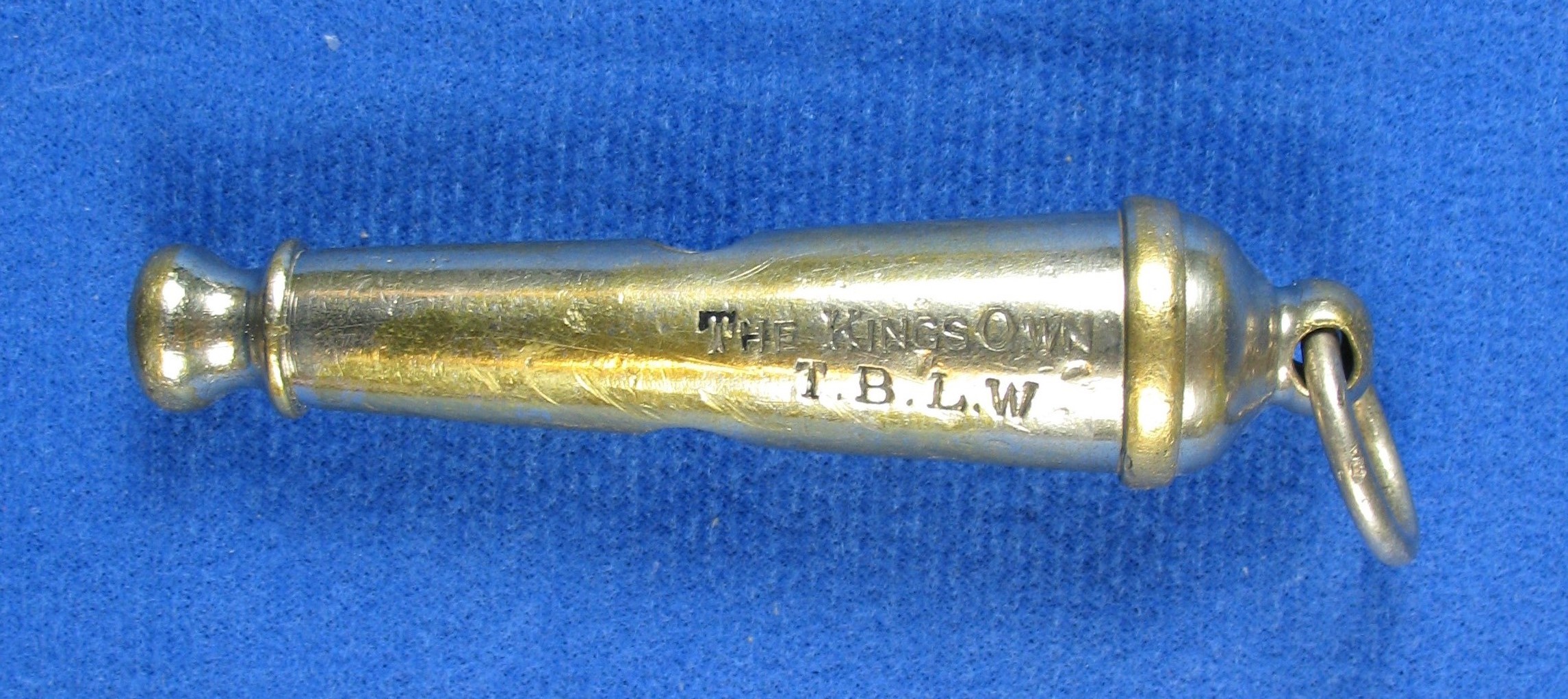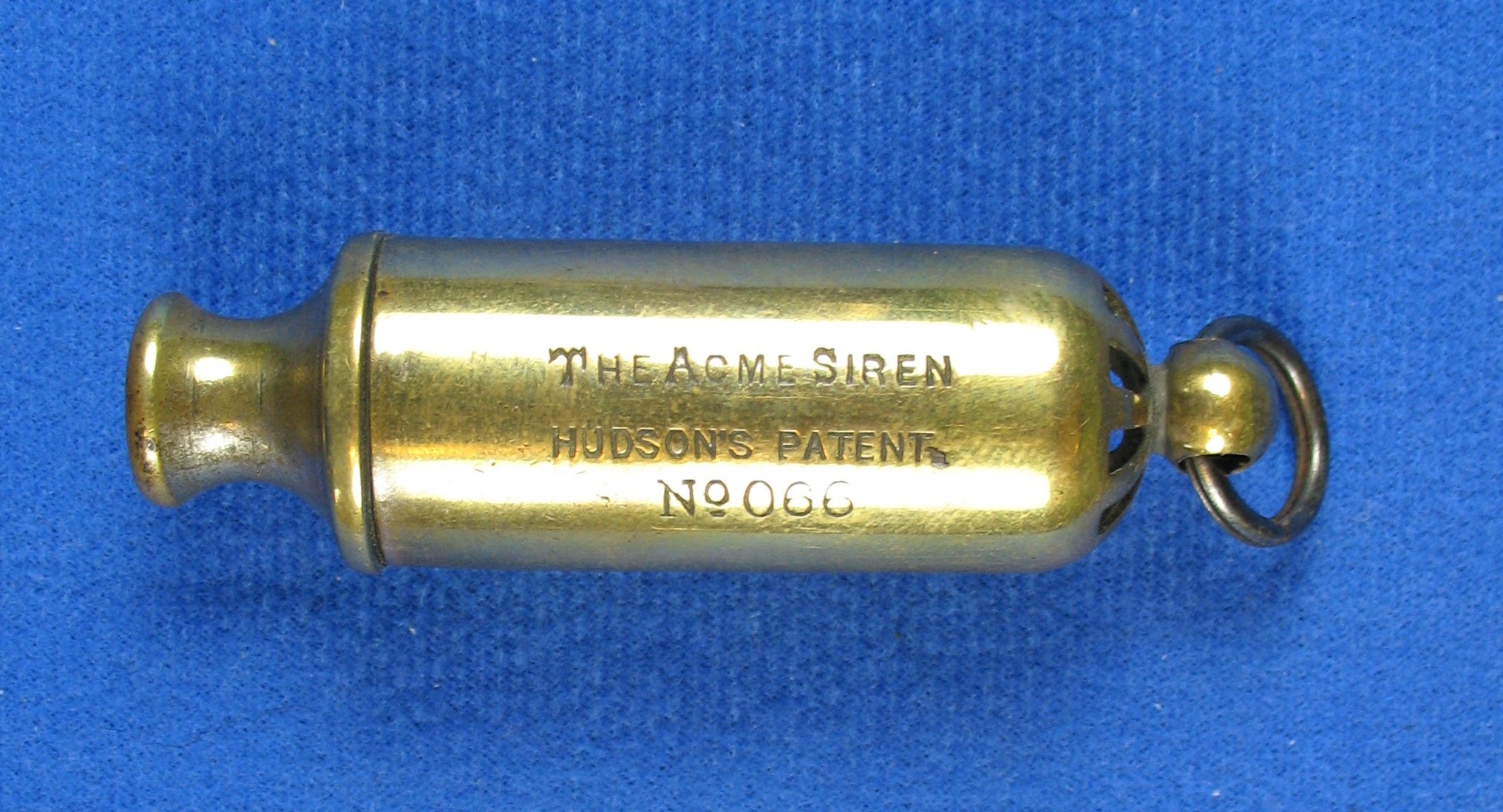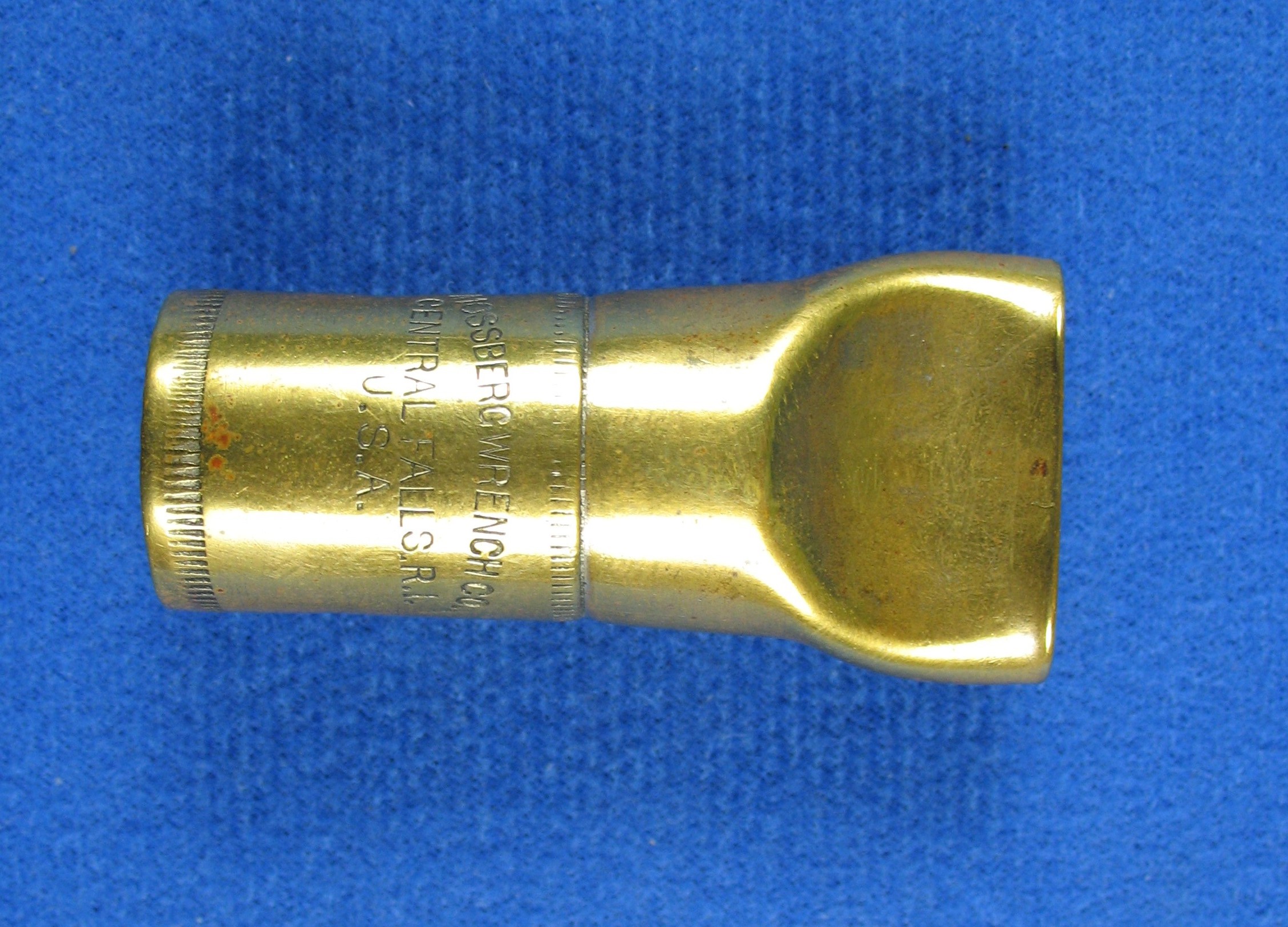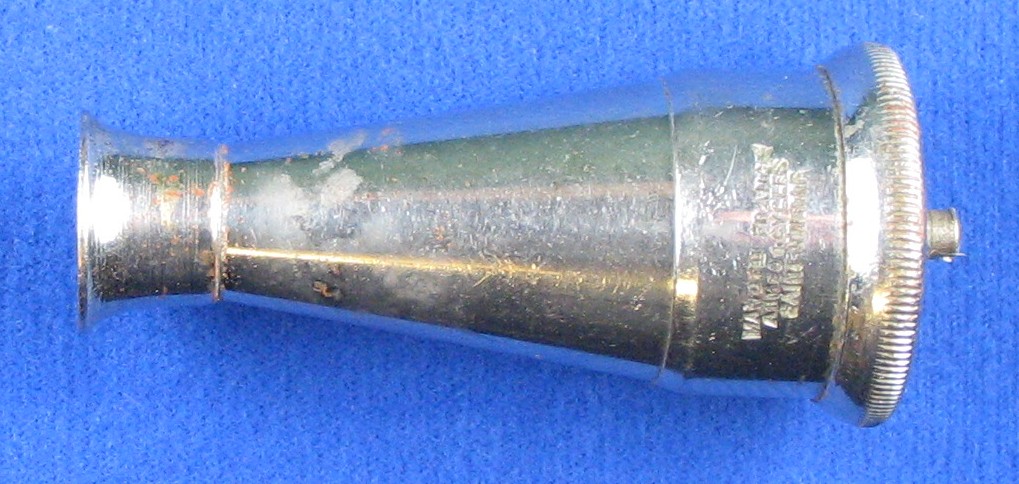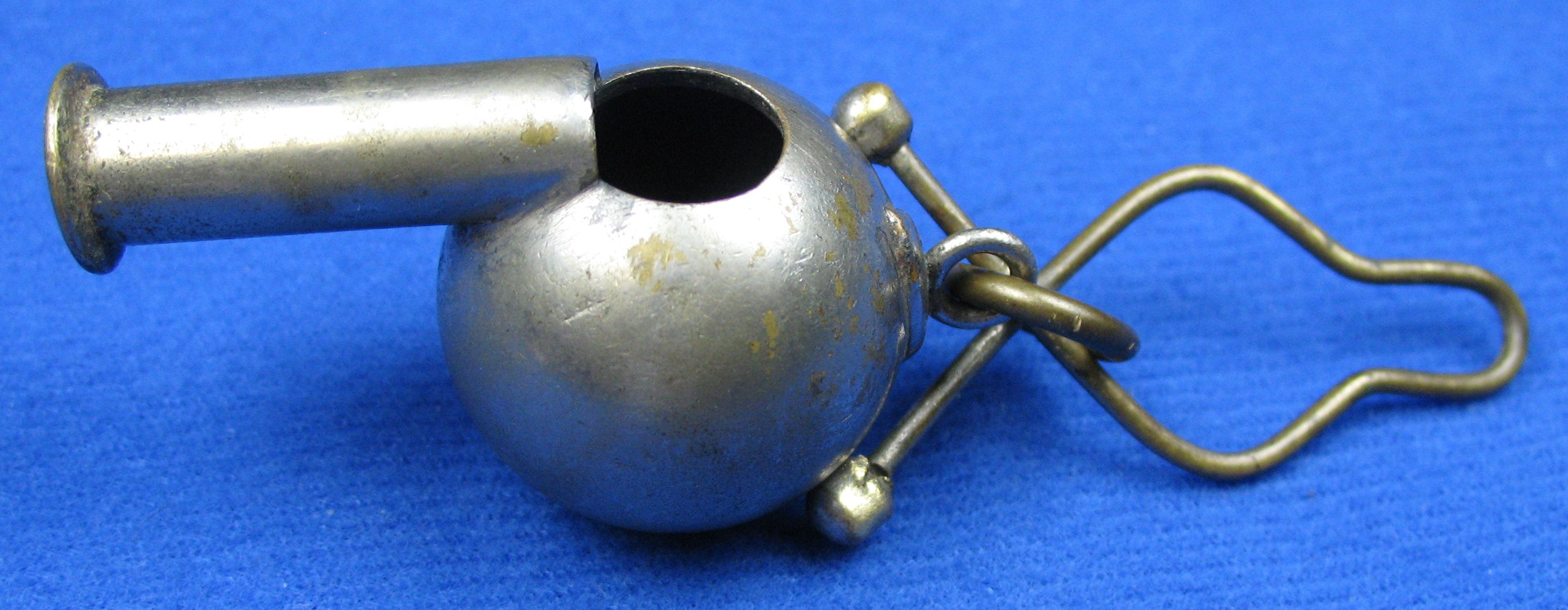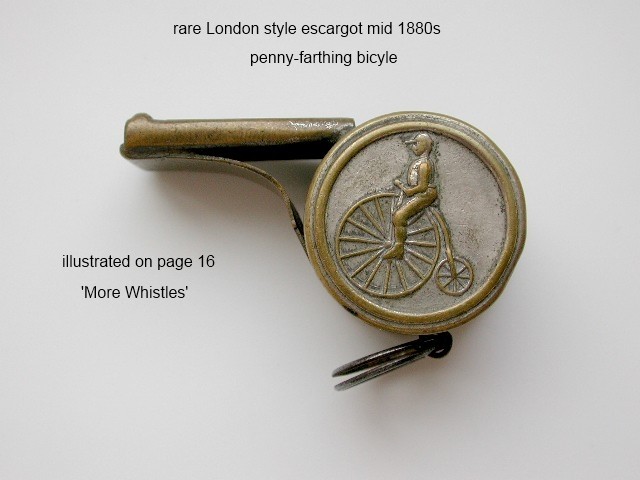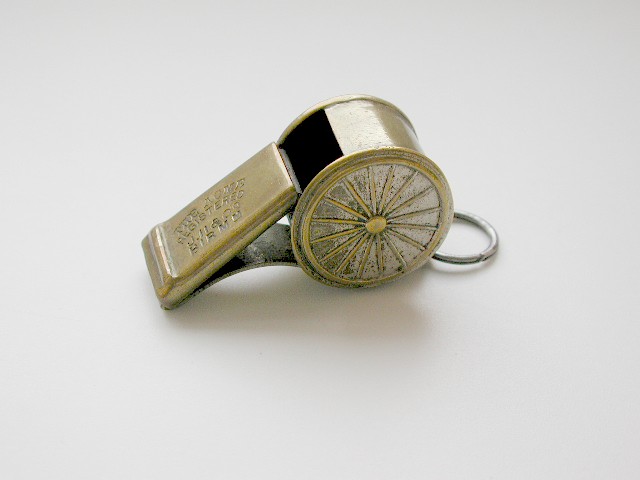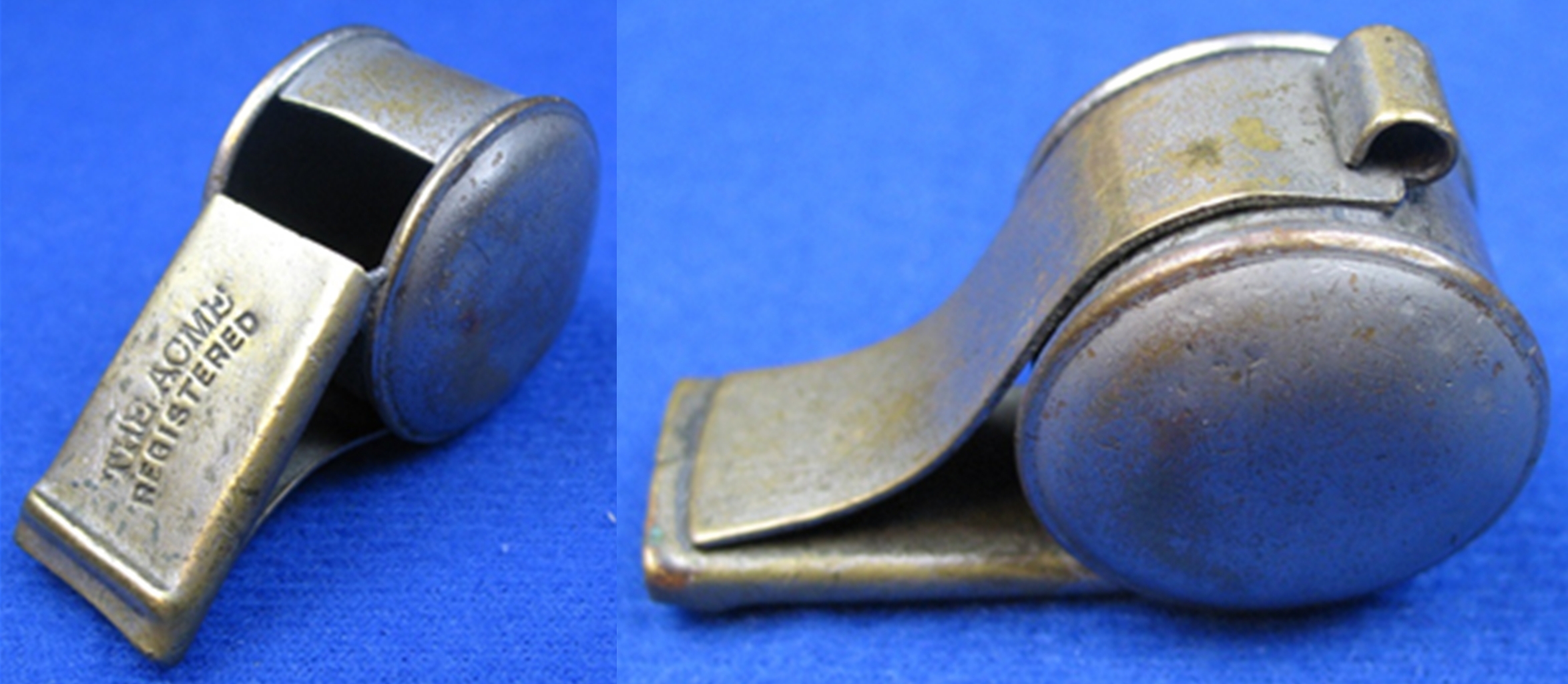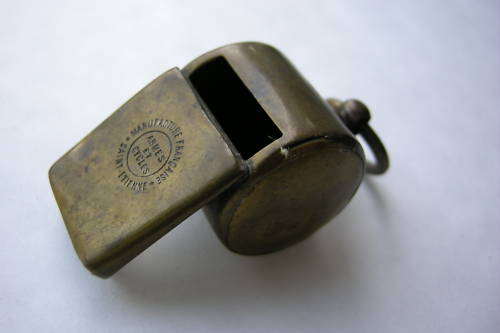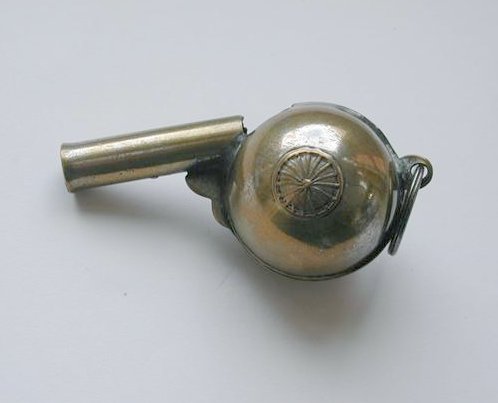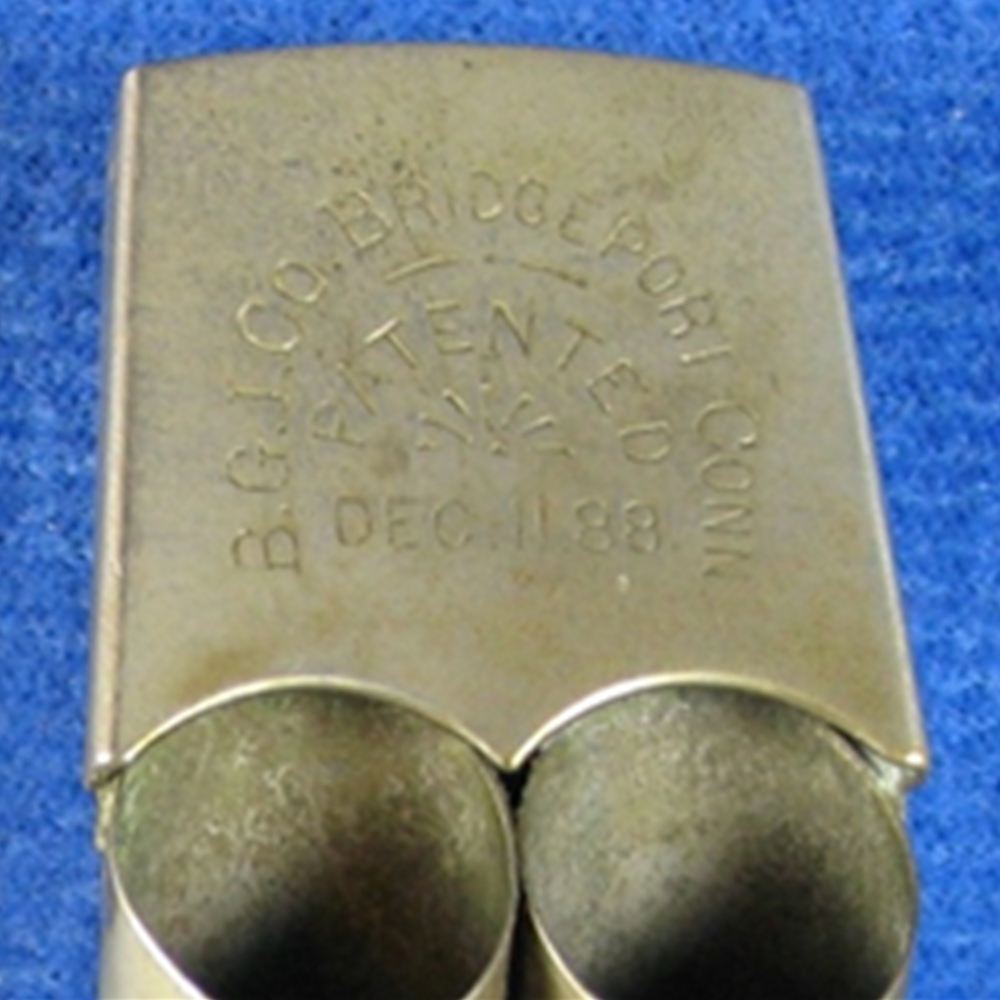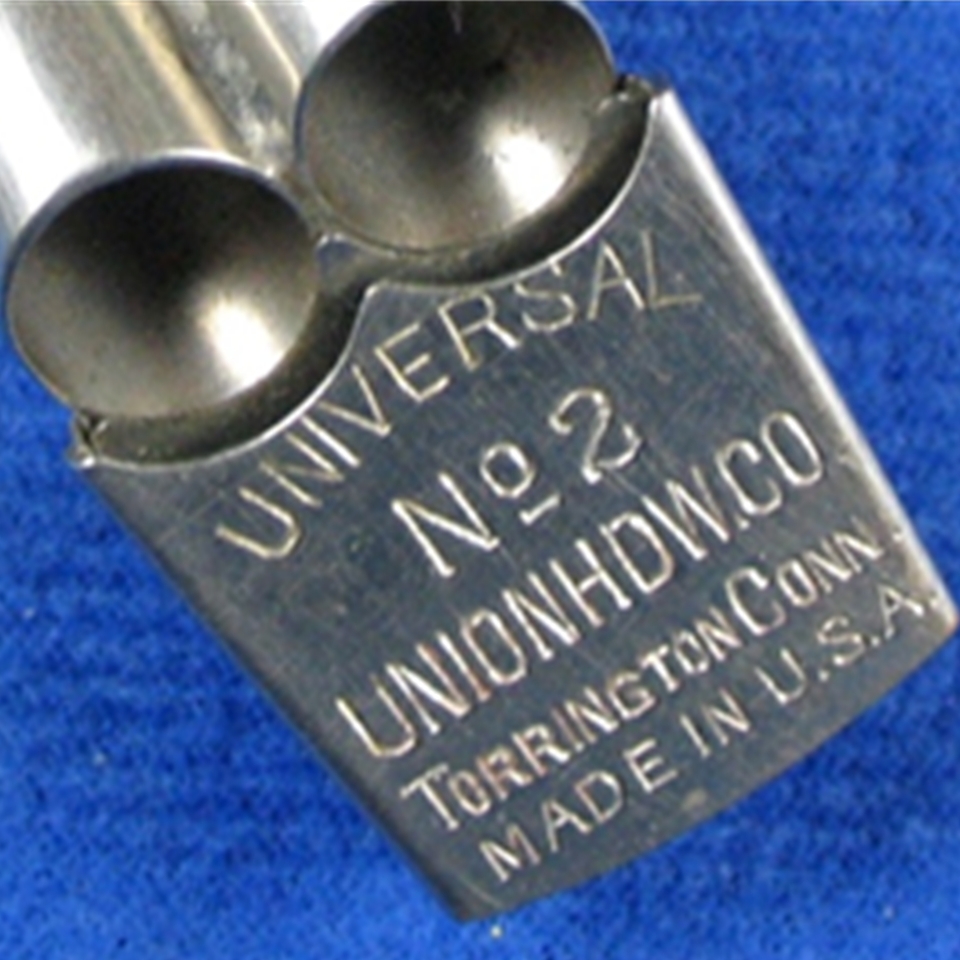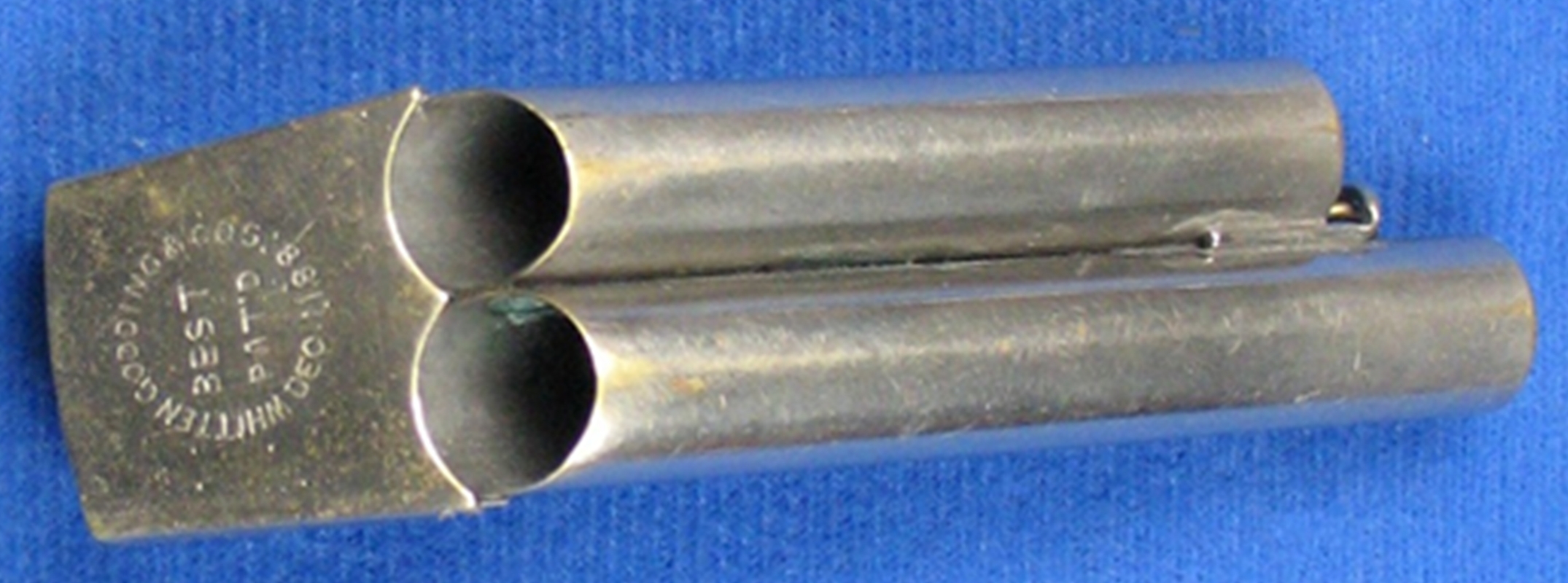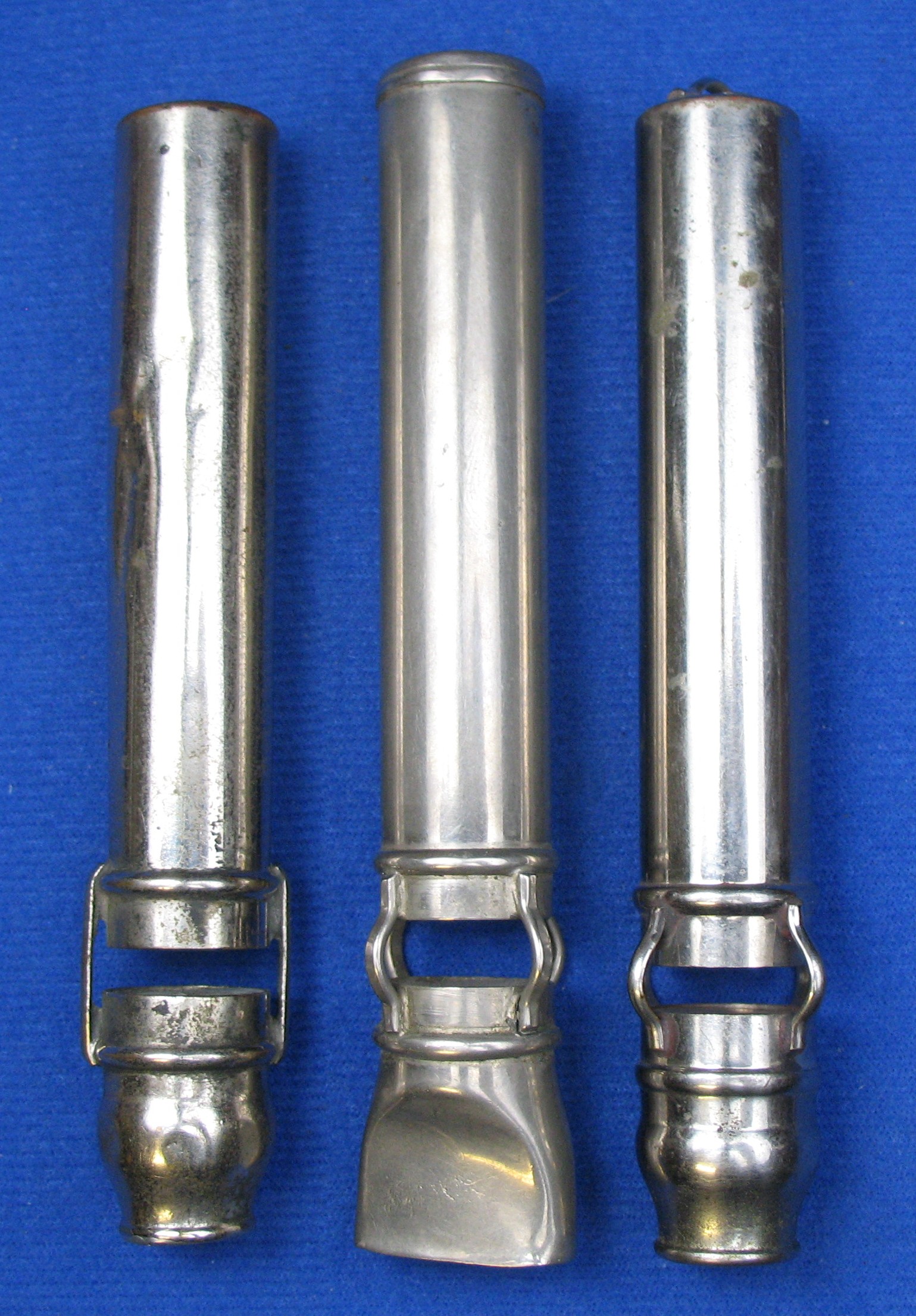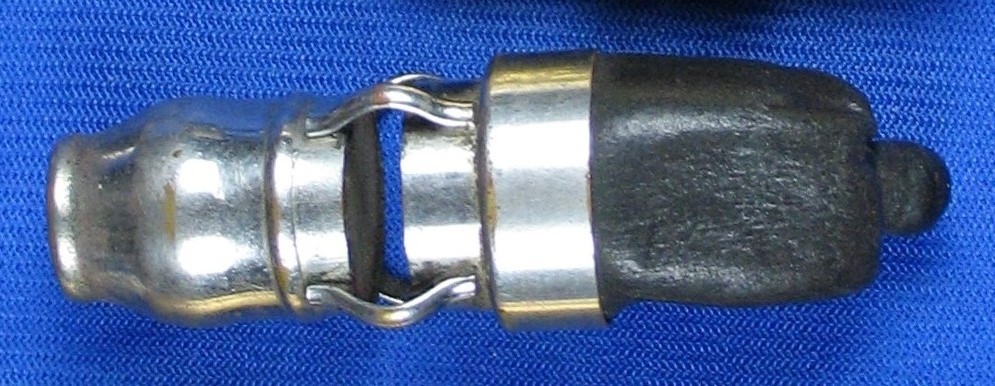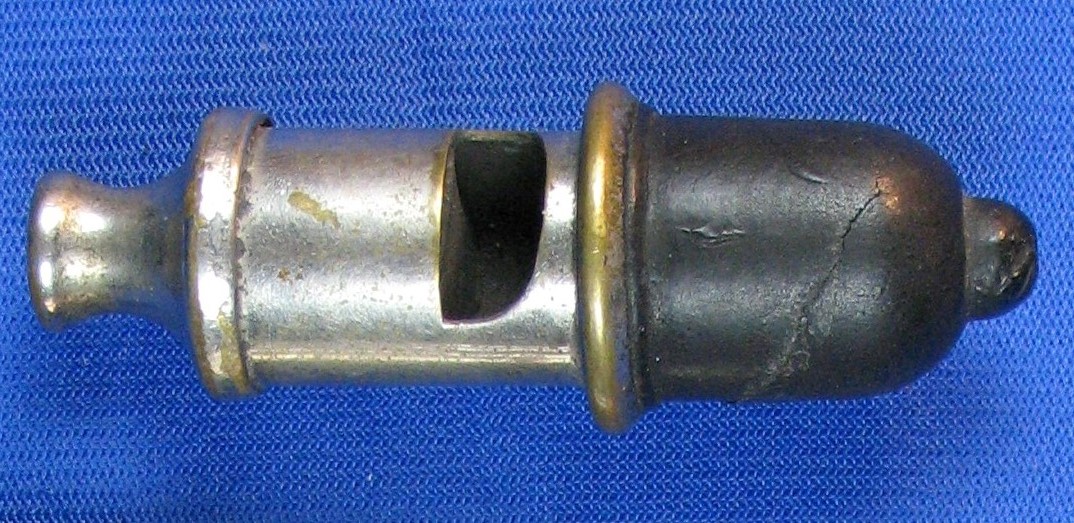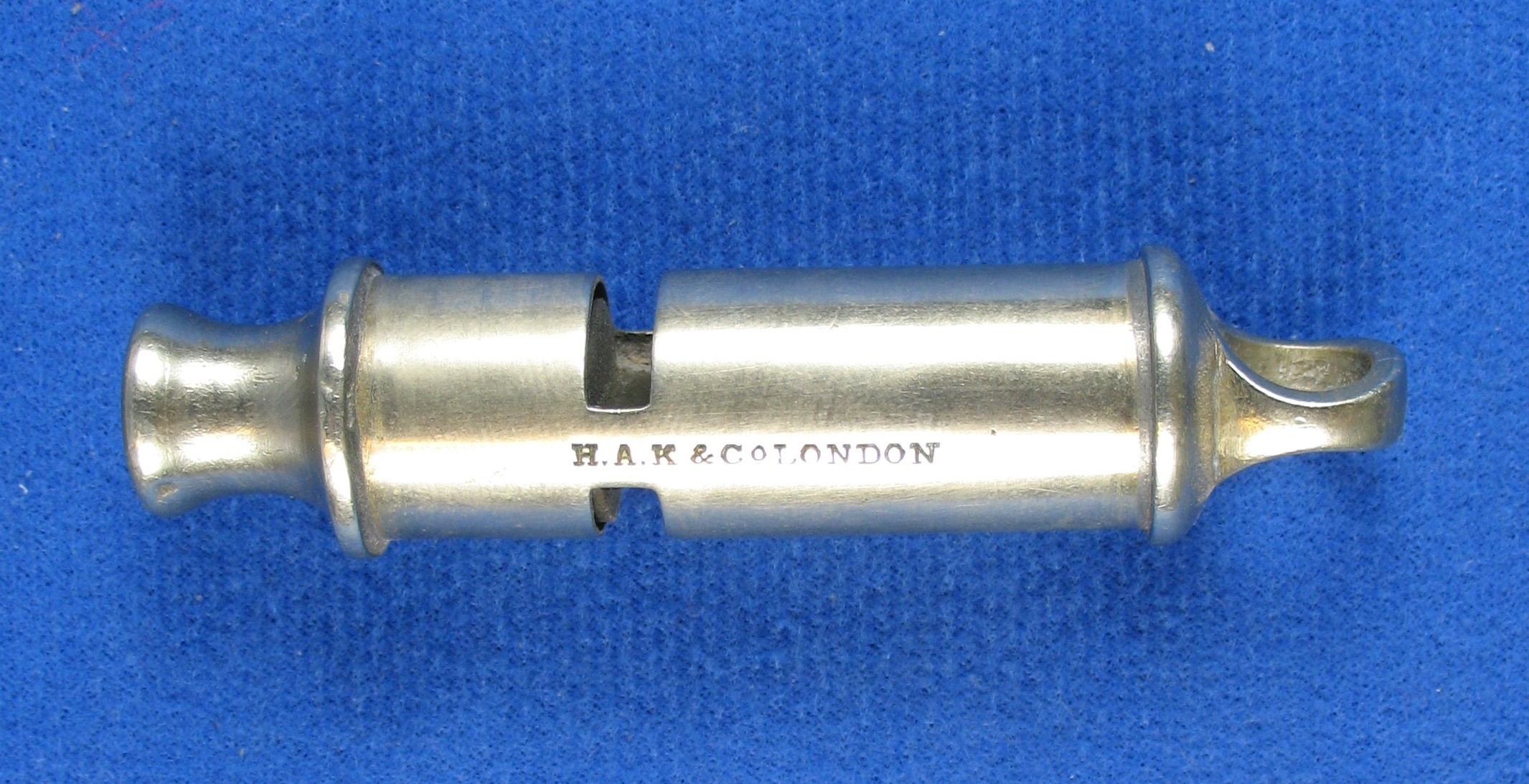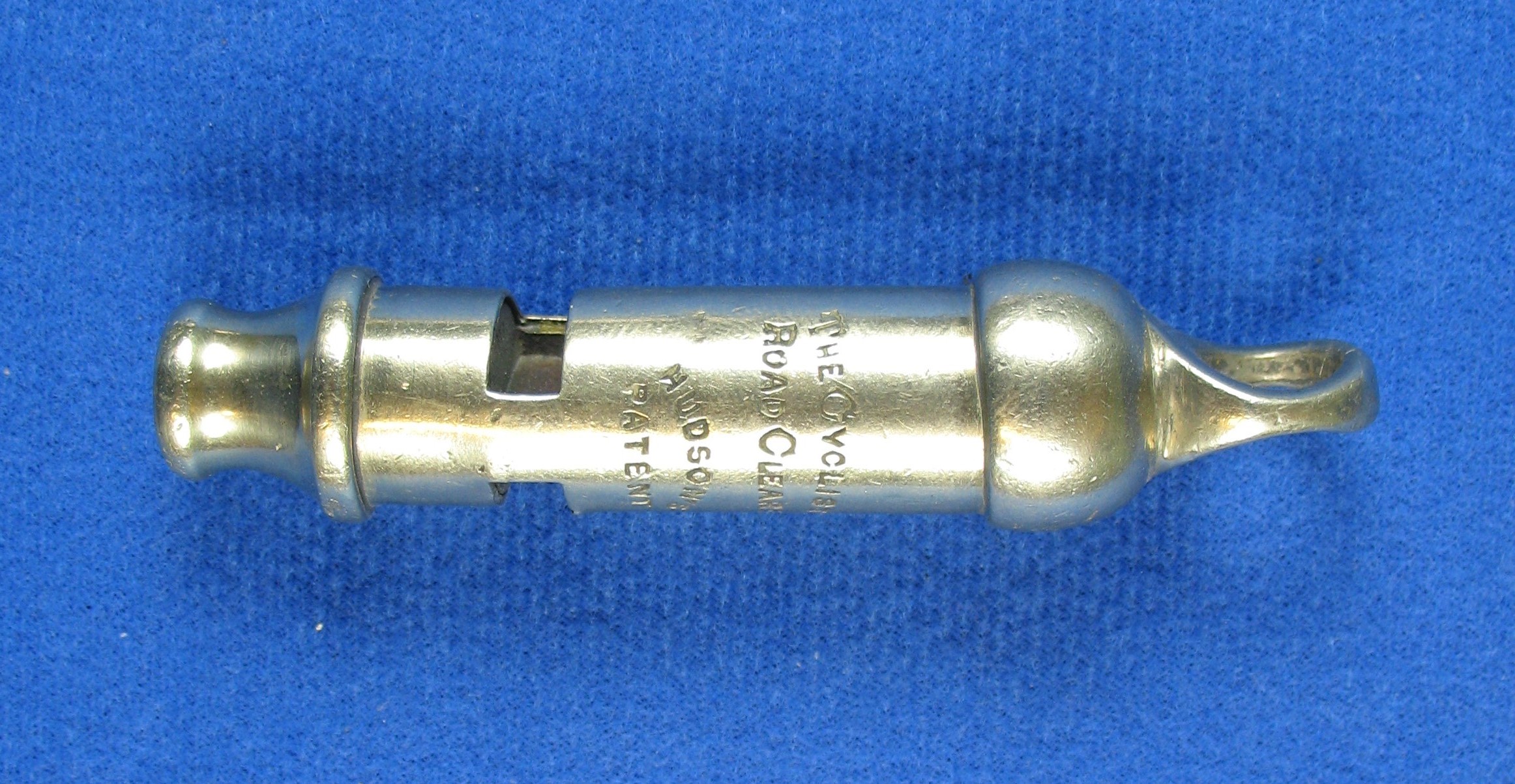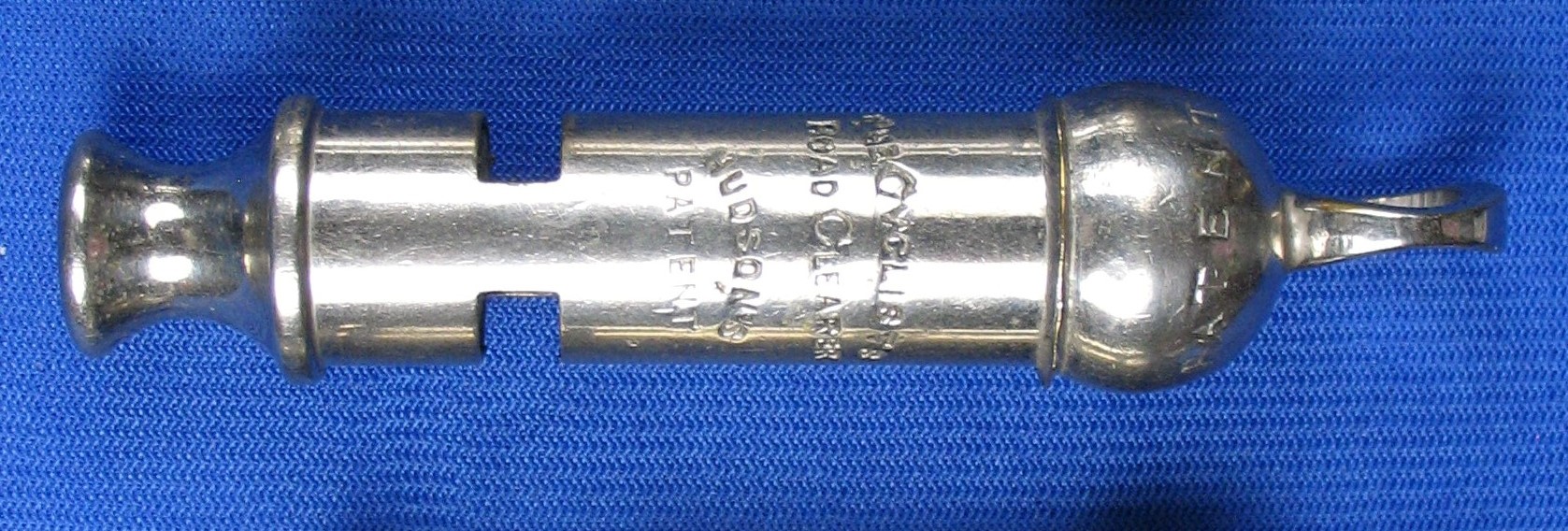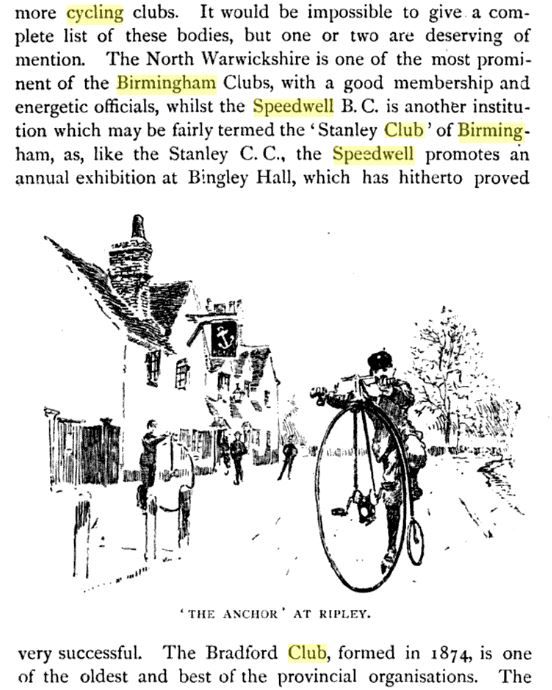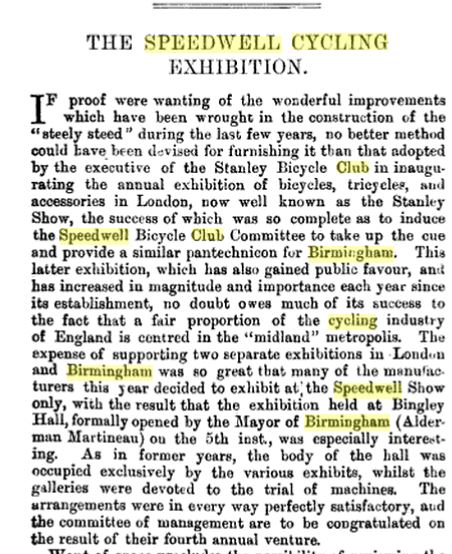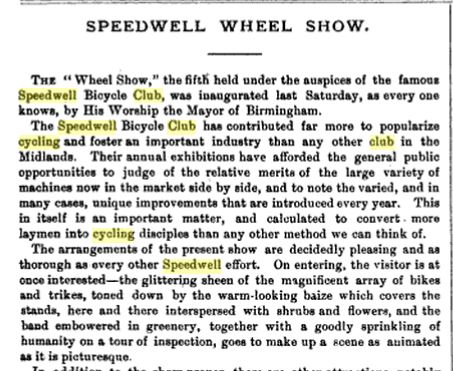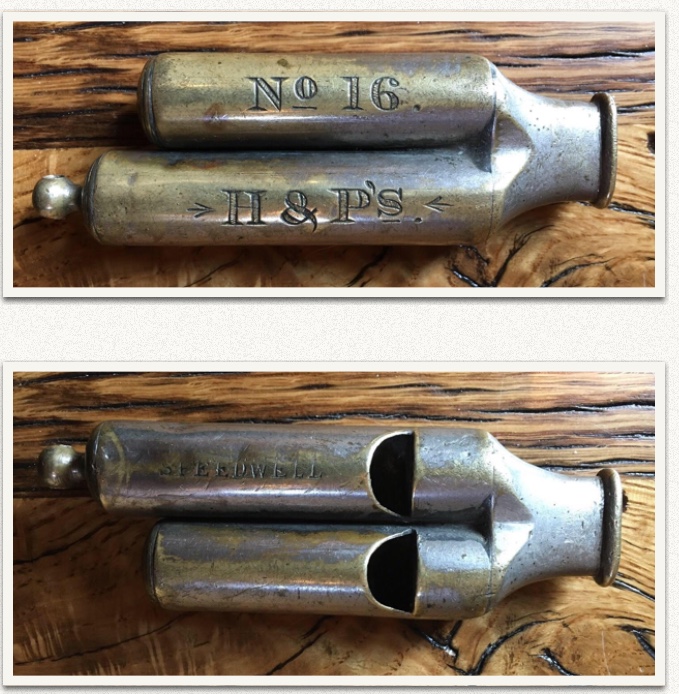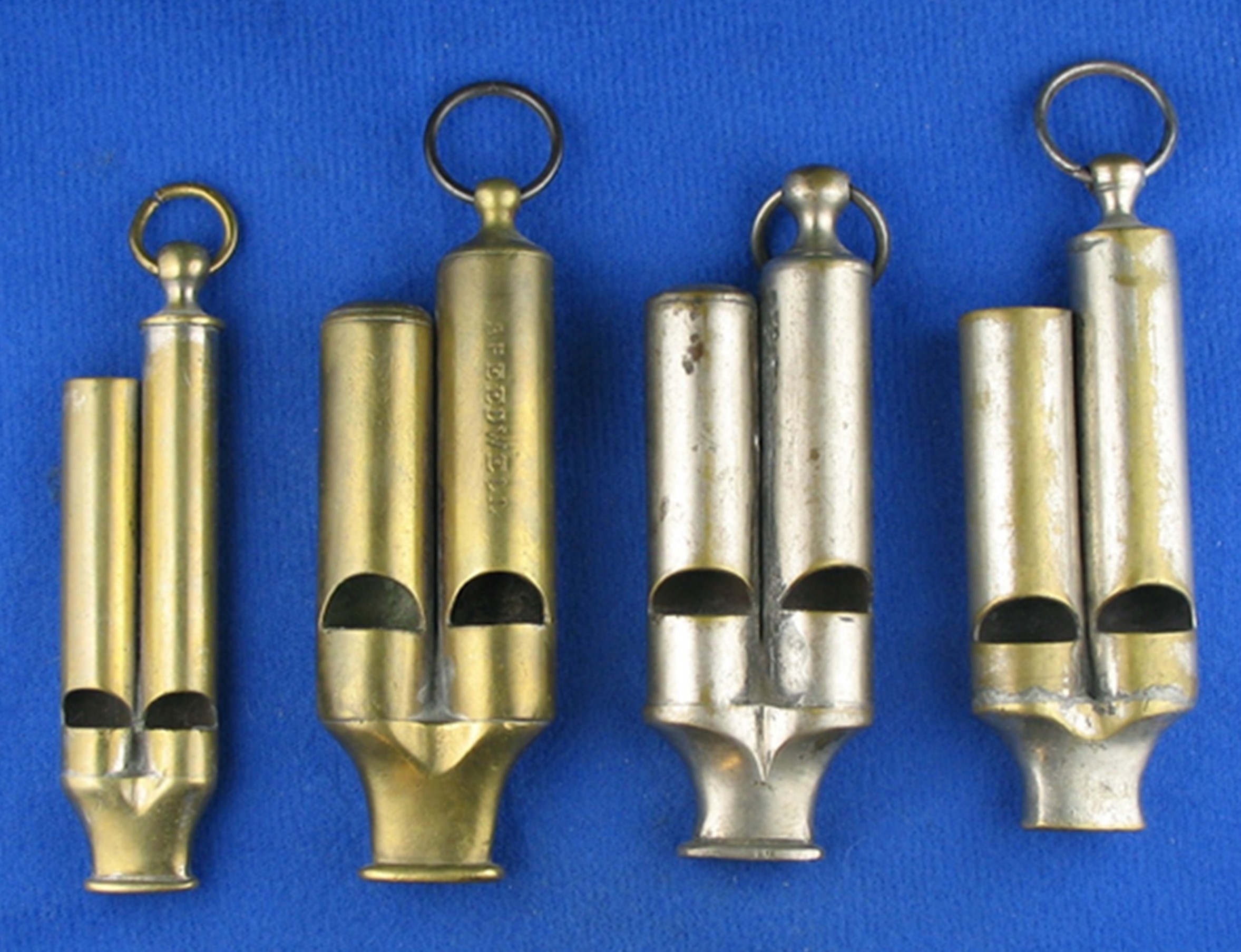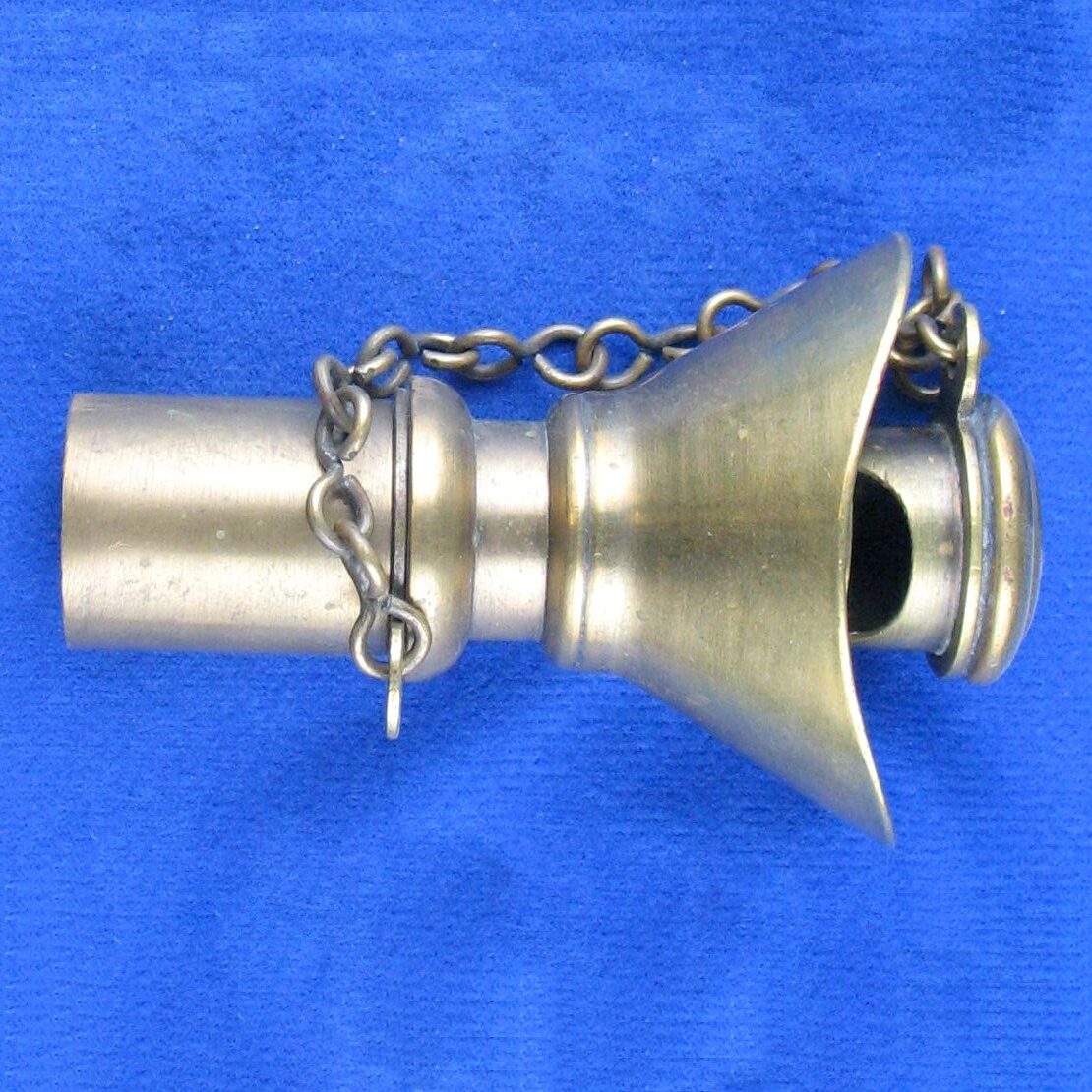Spotlight > Whistle Categories > Cycling > 082
WHISTORY –Cycling whistles have long deserved a comprehensive article. Indeed, there are spotty bits of information scattered on the internet if one searches with diligence. There is even less in literature. Especially weak is documentation. Whistles posted without documentation merely point to the one who posts them. Our efforts are to highlight the whistles only and to do research that provides a sound basis to build on.
We find cycling whistles are what has been referred to by some as a ‘crossover’ collectable; consequently they are able to demand some very high prices, as bicycle collectors tend to spend more money than the average whistle collector. Not always the case, but it is not unusual for an 1885 – 1895 UK or USA cycling escargot to reach 300 to 500 dollars and beyond that, they come up rarely. Others such as manufactured by La manufacture Francaise d’armes et cycles that are not so well known can be reached for far less cost, at least for the present. Perhaps due to scarcity and being somewhat vague as to what constitutes a ‘cycling’ whistle so little is found.
This being the case, since information has been obscure or at least not collated, here is we will classify and record specifically metal cycling whistles ( and sirens ) along with a coordinated timeline of cycling itself to parallel up to. It is good to keep in mind that with whistles such as police, military, fire brigades and the like, any whistle cycling or not, can be used by a ‘cyclist’ and then called a ‘cycling’ whistle by that person. Here we will make every effort to restrict our studies of cycling whistles to a specifically marketed group — by using manufacturing companies, advertising, known stamps, as well as catalog listings. Sometimes the lines were blurred with the aggressive sales efforts in the past by ‘remarketing’ what was a different category whistle, to try to pick up sales from another market, in this case cycling.
One example for instance, is the BGI model 601 bullet whistle, initially for the hunting market and then ‘remarketed’ much later for cycling in an advertisement. It did not in any way fit the profile of a cycling whistle. We will try to stay with the original purposes of each whistle and siren. The first thing to establish is a ‘golden age’ of cycling to work within. Hopefully we can then parallel up whistle manufacturing into this time period, aimed at the cycling period.
This has been a huge undertaking and consumed years to gather. Please feel free to write us and include anything we may have missed and we will edit accordingly. Pictures are especially welcomed. We have included a few pictures without credit as they were captured from the internet years ago. Please contact us for permission and credit as we highly respect copyrights and will not claim that right of the original owner of these pictures. The descriptions and classifications were important enough to see the need to make this effort.
The most common countries of earliest bicycle history we found were Germany, Scotland, France, UK and the USA. Asian records are not available for inclusion, but we hope one day they will be.
WHISTLE ARCHEOLOGY:
important milestones…
1534 earliest design — Leonardo Da Vinci’s time period
1818 Dandy horse, Karl Von Drais ( no pedals) — Laufsmachine (velocipede – lit. running machine )
1860s The term bicycle coined in France
1863 rotary cranks
1868 Invention ‘spoked wheels’ and the high wheel design by Eugene Meyer ( France )
1871 James Starley UK – father of British cycling industry and Safety bike
Names:
Bone shakers
Ordinary
High wheeler
Penny farthing — front wheel the penny, rear wheel the farthing ( smaller )
High wheel bicycle
Velocipede
GOLDEN AGE OF CYCLING — 1870 to 1910 (arbitrary)
1870 to 1885 – the High wheel period (15 year span)
1885 to 1910 — the safety bike ( 25 year span )
TRIVIA:
( Many early advertisements feature women in the pictures )
Susan B. Anthony "Let me tell you what I think of bicycling. I think it has done more to emancipate women than anything else in the world. It gives women a feeling of freedom and self-reliance. I stand and rejoice every time I see a woman ride by on a wheel…the picture of free, untrammeled womanhood."
By the 1890s, Chicago was the bicycle manufacturing capital of America. Eighty-eight local companies produced nearly two-thirds of the nation’s bicycles.
The onset of automobiles ended the golden era of cycling
Headlines when Annie Kopchovsky, a Jewish mother of three, became the first women to cycle around the world on her Chicago-made Sterling brand bicycle.
( An excellent TIMELINE is presented on — http://www.ibike.org/library/history-timeline.htm )
MAJOR WHISTLE MANUFACTURERS:
Banks and Brother
B&R
Bridgeport Gun Implements
Bull and Haynes ??
F.L. Johnson
Gormally and Jeffery
Hudson Whistle Company
Hall Manufacturing
Ivor Johnson
La Manufacture Francaise D’Armes et Cycles
Martin Signal ??
Mossberg Manufacturing Company
Overman Wheel Company
Stevens and Sons
Union Hardware
Ward, H.A.
Waterbury Button Company
Whitten – Godding Cycle Company
Zimmerman, Julius Henrich ??
CHRONICLES:
1820 — 1901 – Stevens – London, England ?
1864 Banks and Brother dual tube whistle patent – New York, New York.
1864 — Union Hardware ( buys BGI 1908 )- Torrington, Connecticut.
1870 to 1900 Gormally and Jeffery – Chicago, Illinois.
1871 — 1993 Ivor Johnson ( cycle works 1891 to C.1930 ) O. F. Mossberg worked there. Fitchburg, Mass. 1876 to 1908 – Ward
1878 to 1908 Bridgeport guns implements – Briggs ‘for bicycles’- Bridgeport, Connecticut.
1880 to date – Julius H. Zimmerman ( Germany )
1882 to 1900 — Overman Wheel Co. ( 1885 Fischer patent assigns to Overman )- Chicopee Falls, Mass.
1882 to date — Hudson – Birmingham, UK
1884 — ?? Bull and Haynes
1885 – 1988 ? La manufacture Francaise d’armes et cycles
1885 — ?? F.L. Johnson – Wallingford, Connecticut.
1886 — ?? Whitten-Godding Cycle Company ( 1894 Providence ) Rhode Island – sells to Pope mfg.
1889 – to date – Mossberg Manufacturing Company ( Mossberg Wrench Co. ) Attleboro, Mass.
1896 — ?? F.J. Hall Manufacturing Company ( manufacturing bicycles )
1910 – 1940 ? B&R
Types of Cycling Whistles:
Two Tube Thin Walls
1) Banks and brother
2) Bull and Haynes
3) Gormally and Jeffery
4) Overman
5) Johnson Whistle Company
6) B&R
7) Hudson
8) Signal ?
9) Sonder ?
10 ) Zimmerman ?
Beauforts
1) Overman
2) Hudson
Sirens
1) Hudson
2) Overman
3) Mossberg manufacturing Co ?
4) Waterbury Button Co.
5) Martin Signal
6) Zimmerman
7) Mossberg Wrench Company
8) B&R
Escargot
1) Ward ( spherical )
2) Hudson
3) Armes & Cycles
4) DeCourcy ( spherical )
Angled Two Tubes
1) BGI
2) Union Hardware
3) Gormally and Jeffery
4) Whitten, Godding and Co.
5) Hudson
Long Tubes
1) Johnson whistle works
2) Hall manufacturing
3) Hatch
Bowl Squeeze Whistles
1) F.L.Johnson
2) Hudson ??
Porteous Top Whistles
1) Stevens
2) Hudson
Dual Tube Heavy Wall
1) Ward
Types of Cycling Whistles (Detailed):
Two tube thin wall
1) Banks and brother
2) Bull and Haynes
3) Gormally and Jeffery
4) Overman
5) Johnson Whistle Company
6) B&R
7) Hudson
8) Signal ?
9) Sonder ?
10) Zimmerman ?
Duplex whistles present a difficulty in that they fade in and out of cycling whistles per se. Here we are endeavoring to include those specifically made by a manufacturer who focused on cycling whistles. Included are those that could of course by its design be used for the same, which are too close to leave out. For example Hudson did not appear to target the cycling craze with duplex whistles at first and may have just rolled into it later.
Included is Martin Signal cycling whistle from an early catalog during the last of this time period circa 1900 which displays a duplex not mentioning cycling. We do not have a Zimmerman catalog to share at this point. The Sonder catalog ( circa 1900 ?? ) does have duplex and several angled 3 and 4 tube whistles listed as ‘radfahrer’ – ‘cycling’ whistles.
Earlier Banks and Brother dual tube whistles had no tooth grip and the original patent picture is different from known whistles (March 29. 1864) which featured an extended round mouthpiece. It was not designed for cycling.
T.C.Banks patented it and assigned it to himself ( Thaddeus C. Banks and Samuel A. Banks ) for use as follows:
“My invention lies in so constructing a signal-whistle that the sound which may be produced by it shall be of such peculiar character that it will be readily recognized and distinguished from any other whistle by the signal officer whose ear the sound was intended to reach… Thus it becomes also valuable for fog-whistles, steamwhistles, &c., in which the identity or location of particular signals is important.”
However it is of note that the flat wall just inside of the mouth piece, uses a serrated teeth design inside on the diaphragm. Gormally and Jeffery would use a flat slightly bent over diaphragm wall with no teeth, as would Overman. This is an important feature to differentiate them.
A tooth grip was added to allow a hands free use. An 1888 advertisement from Horton, Gillmore McWilliams &, Co. for bicycle sundries displays a duplex whistle. The picture features a straight mouth duplex whistle prior to this adaptation of the curled mouthpiece opening.
The two other whistles are BGI whistles in the same advertisement. Whether this is a Banks and brother duplex is uncertain. Our catalogs are limited.
Early catalogs by BGI do not picture any duplex whistles, at least to 1892. The earliest is dated catalog we have is 1902 with one in the Marcellus Hartley catalog ( owner of BGI ). It appears that Banks and Brother dominated the market at first. If and when they targeted bicycles is uncertain.
Included are pictures of mouthpieces showing a straight and curved design improvement. This became the standard allowing a hands free use. Note the tops are very rounded. The diaphragm is flush with the bottom of the window opening.
An obscure picture note to look for is for Bull and Haynes. Who manufactured this whistle is unknown without an example. The picture is without credit and incomplete. Bull and Haynes ( W.S. Bull and Gid Haynes ) started in 1884 in Buffalo, New York obtaining the 5th bicycle license in the USA at the time.
Gormally and Jeffery Manufacturing Company were located at 222 and 224 No. Franklin St. Chicago ( 1886 advertisement ). Known as G & J. Consisting of R. Philp Gormally and Tom Jeffery were at one point considered the 2nd largest bicycle manufacturer in the USA. 1878 to 1900. They had a plant that filled half a city block at North Franklin and Pearson Street in Chicago.
The duplex whistle modeled after the Banks and Brother, had no teeth inside the diaphragm compartment.
The Overman duplex is similar at first. However it diverges with squared off windows instead if half round. The diaphragm is well recessed inside and the duplex tubes are once again of very different lengths.
Alvin L. Fischer patent – June 30th 1885
“My invention relates to an improvement in that class of whistles or calls having two sheet metal tubes, each of different length, and a common mouth-piece for them of the same material, the object being to the better adapt whistles or calls of this class to the use of wheelmen ( italics added ) by improving them in respect of their durability, finish, and convenience.”
This patent was assigned to the Overman Wheel Company.
The F.L. Johnson is the premier duplex, being larger and better built by far. It was a very high quality whistle. The design for sound ran around the tube edge and produced a much hollower sound, perhaps not as high pitched as would be needed. This whistle was specifically designed for the bicycle trade.
Patented January 29, 1889 as follows:
Be it known that I, FREDERICK L. JOHNSON ….. “have invented certain new and useful Improvements in Bicycle-Whistles.”
B & R followed the design of Gormally and Jefferies. When B & R started manufacturing whistles in unknown, but it appears that they took up production at the time G & J stopped, utilizing the serrated teeth design…
Hudson is a 1910 Hudson catalog displayed as model 145 — aimed at cycling – the Yankee.
Sonder’s catalog clearly stating radfahren ( German – to go biking )
Beaufort
1) Overman
2) Hudson
Beauforts are low on the totem pole for cycling whistles. For the most part the conical design rejects easy use. However some manufacturers made adjustments at the opening, modifying it to be gripped with the mouth while riding. Here another high quality whistle was designed by Overman. It was heavily built and rather large at 88 mm ( almost 3 ½ inches ).
Hudson manufactured two beaufort models stamped TBLW The Kings Own. It was produced for years in two models, a hollow knop top and standard knop top. TBLW stood for Thomas Bowling Lamp Works, after Joseph Lucas works in Little King Street, Birmingham. The name The King’s Own was used as a trade name for Lucas Lamps, who also made bicycle lamps.
The following lefthand whistle is probably manufactured by Alfred DeCourcy. The whistle opposite looks to be made by Hudson.

(Added June 23, 2018)

(Added June 23, 2018)
Siren
1) Hudson
2) Overman
3) Mossberg manufacturing Co ?
4) Waterbury Button Co.
5) Martin Signal
6) Zimmerman
7) Mossberg Wrench Company
8) B&R
Perhaps it comes as a surprise that sirens were also at the top of the field in whistle manufacturing targeted for cycling. They were made by whistle makers so are inclusive. However their category might be considered a tangent of true whistles. Their entry into the market did not occur until 1895 when they were patented in three designs in three countries ( i.e. Germany, UK, USA )
Hudson’s design of the cased siren really did not emerge until 1909-10.
Overman called the Victor Siren Overman Wheel Co. produced a siren dedicated to cycle use following the patented design of Simon W. Wardwell Jr. and Frank Mossberg assigned to the Mossberg Wrench Company – 1895
Nothing is described in the original patent about cycling whistles.
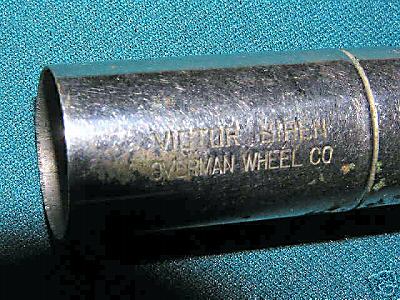
Photo Credit Unknown
(Original picture as sold on eBay)
Mossberg eventually moved to Iver Johnson Arms and Cycle works in 1891 ( ended 1907 ). From 1894 through 1941 catalogs, no variant of the Mossberg siren is advertised. Here is the originally patented model.
FERDINAND PIETSCHMANN Jan 16, 1895 patented the ‘torpedo’ siren. This torpedo aimed at cycling was in France, Manufacture France D’Armes and Cycles Saint-Etienne.
Escargot
1) Ward ( spherical )
2) Hudson
3) Armes & Cycles
4) DeCourcy ( spherical )
From Ward’s Russell Street catalog model number 35 is this spherical whistle. This would place it almost 20 years before Alfred DeCourcy would market a similar spherical whistle dedicated to cycling. Likely the Ward whistle was originally for hunting. Circa 1880.
Perhaps the highlight of cycling whistles is the escargot class. Especially those from the 1880s and Hudson dominated the field.
The first shown actually was manufactured for Penny-farthing cycles, so named after a penny size comparison to a much smaller farthing coin to describe the wheel ratios.
Another unknown maker showing the high wheel design with an improved tooth grip :
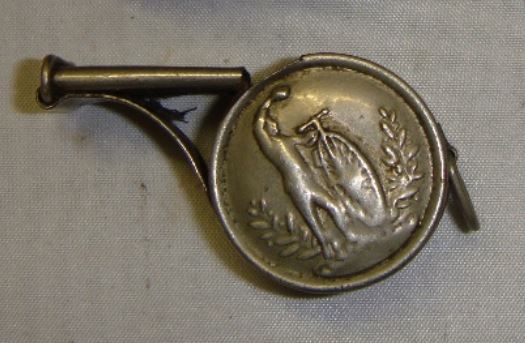
Photo Credit Unknown
(Original picture as sold on eBay)
Hudson showing the spokes of a wheel:
On page 16 top of the page Gilchrist displays three escargots ( two shown already ) including the next one.
Armes ET Cycles Manufacture Francaise Saint-Etienne
DeCourcy spherical escargot seen in plastic on page 73 More Whistles ( Gilchrist ) with spokes on the side, then in metal here, sold on eBay.
Lastly a rare escargot won on eBay for 350 gbp in 2016. James Whiteley and Company Meadow Lane, Leeds, closed bicycle shop January 9, 1902. ( Acme Wheeleries 1879, Whiteley brothers ) Maker unknown., circa 1890. Possibly Joseph Hudson Co.
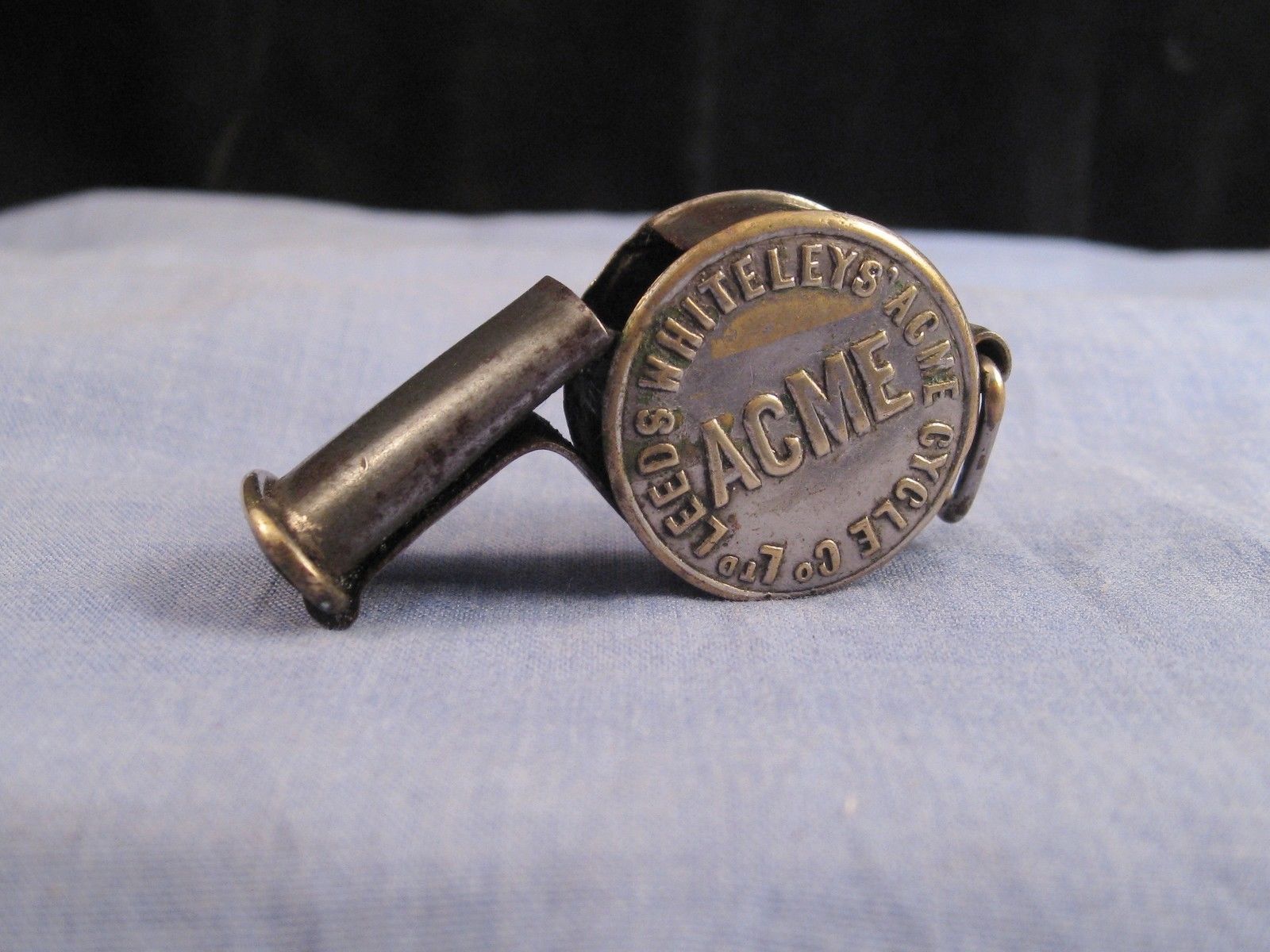
Photo Credit Unknown
(Original picture as sold on eBay)
Angled two tube
1) BGI
2) Union Hardware
3) Gormally and Jeffery
4) Whitten, Godding and Co.
5) Hudson
Sylvester R. Briggs patented the angled mouth whistle for cycling December 11, 1888.
“My invention relates to whistles of the class adapted to be used more especially by bicycle riders, car-drivers, and other persons in giving signals.
At some point early on BGI was able to acquire the patent rights and started producing it with their stamp on it and was offered in three sizes.
( Several companies picked up on the design in the UK and USA.)
Later it was changed to the Universal by Union Hardware.
A catalog for Lee Clarke Bicycle Sundries dated 1894 had a F.L. Johnson whistle and by 1902 BGI and Union Hardware were mixed with whistle production. The angled mouthpiece whistle being sold as the Universal 1902 in a Marcellus Hartley catalog.
Whitten and Godding offered their own. None have been found by Gormally and Jeffery. ( we are looking )
La manufacture Francaise d’armes et cycles.
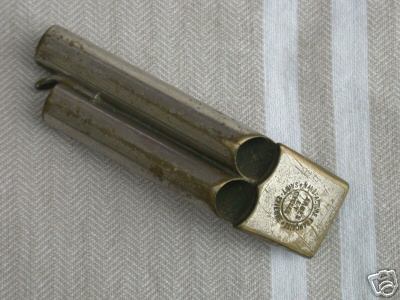
Photo Credit Unknown
(Original picture as sold on eBay)
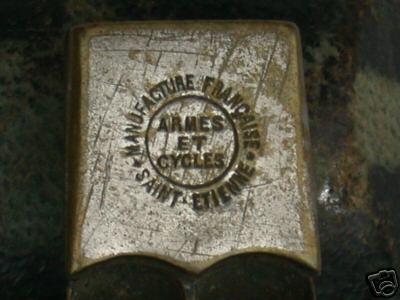
Photo Credit Unknown
(Original picture as sold on eBay)
Long Tube
1) Johnson whistle works
2) Hall manufacturing
3) Hatch
The distinctive long tube whistle by F.L. Johnson was made directly for the cycling arena as the following quote shows from the patent description of January 29, 1889 :
“have invented certain new and useful Improvements in Bicycle-Whistles”
Here are several examples ( far left is closer to February 21,1899 patent ) Far left was not marketed for cycling.
Patented August 29, 1899 was a split level design unsoldered sides and was not marketed for cycling.
Bowl squeeze whistle
1) F.L.Johnson
2) Hudson ??
These were seen since at least an 1888 advertisement. A similar design with squeeze BOWL is seen 16 years later in a 1904 patent. Hudson also advertised them.
F.L. Johnson squeeze bowl circa 1890.
Hudson ( ? ) squeeze bowl. Circa 1900.
PORTEOUS TOPS
1) Stevens
?2) Hudson
1880s by Stevens and Sons, titled the Road Clearer. Also stamped at times on the reverse side a distributor named H.A.K. for Henry Augustus Knox trading as H.A.Knox and company. They were located at 65 Tuffnel Park-road, Middlesex, a hardware and importer of German and American goods.
It appears to have been distributed in the 1880s-90s in two different models.
Later model without the Porteous top. It is shorter.
Hudson’s Road Clearer came in three variations of Porteous tops.
Dual Tube Heavy Wall
1) Ward
Possible cycling whistles: heavy walled dual tube whistles.
In CPWs listings of Lilly whistles we find Speedwell stamps and Improved Speedwell. Lilly proved to be an outlet for Henry Arthur Ward whistles. The dual tube heavy walled whistle was his model 11 with Speedwell stamped on them. A trade name related to a suburb of Birmingham. How did it come about?? Is it possible that it was named for the Speedwell Cycling Club ( began 1876 ) that was prominent the 1880s. An 1887 cycling magazine focuses on high wheel cycling.
1885 knowledge:
1886 The Dart and Midland Figaro:
Charles W. Bennet raced in the Speedwell Cycling Club in Birmingham ( C. 1880 ) and went to Australia to join with Charles L. Wood ( both Penny Farthing enthusiasts) in 1882 to form the Speedwell Cycling Club in Australia.
Grace’s Guide:
Speedwell Bicycle Club was probably the earliest and certainly the most prestigious of such clubs in Birmingham. Founded in 1876 its headquarters were in Edgbaston’s Speedwell Road.
Five annual exhibitions devoted primarily to cycles were organised by the Speedwell Club during the 1880s, the first one in March 1882,
These are all manufactured by Henry Arthur Ward. However during this same period of time Hudson ( C 1885 ), DeCourcy and Barrall made their own models into the 1890s. They were discontinued later into the 19th century’s end except possibly Alfred DeCourcy’s who continued perhaps into the post 1910 era and pre war. High wheel cycling had given ground to safety bicycles by this time.
There are more whistles to post. At least two others known that are very rare we have no pictures of. As we find them or at least receive pictures we will post them as an addendum for us all to refer to.
– TWG
Posted January 5, 2018
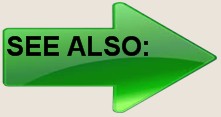
007 Alfred DeCourcy Part 1 |
024 The Underrated Escargot |
043 Edward Davis Bean |
|
047 Angled Thin Walls |
048 Duplex Thin Walls |
© 2025 – All photos with blue background property of The Whistle Gallery reference collection.
Use of photos without authorization is prohibited. – Gallery questions, please contact [email protected].
Bibliography
The Wheelmen ( online )
National Clustered Spires ( online )
amhistory.si.edu ( online )
interactive.wttw.com (( online )
ibike.org
vintagebicycle.wordpress.com ( article )
History of the Old Colony Railroad:A Complete History of the Old Colony Railroad from 1844 to the present time in two parts
British trade journal number 9
London Gazette Jan. 21. 1902
Fish and Chips and the British Working Class, 1870 to 1940.
Cyclist
Grace’s guide
The Dart and Midland Figaro 1886
Knowledge 1885
Hardware Buyers Directory 1898
Whitten Bicycle Company. Providence Journal of Commerce (May 1896): 18-20.
Motor Cycle Illustrated Vol. 18
For Iver Johnson
French Cycling: A Social and Cultural History
